Inside: The complete list of blue birds (blue colored birds) in the US and Canada including a full-color photo of each blue bird, details about their habitat, diet, appearance, nesting habits, and a range map to show you where in the state you may see them.
There’s something about spotting a blue bird (a blue-colored bird to be more exact) in your yard that gets your heart pumping. Luckily there are plenty of types of blue-colored birds across the US and Canada so your chances of seeing one are very good. And I don’t just mean the famous bird called the “Eastern Bluebird“. Yes, this blue beauty is included but oh so much more.!
With more than 20 years of experience attracting backyard birds to my yard, I’ve seen every blue-colored bird species in my area (Wisconsin) and acquired a lot of knowledge about these blue birds. For those species that are outside my area, I have my trusty sourcebooks and friends at The Cornell Lab of Ornithology to guide me.
I’ll never forget my first blue-colored bird spotting – which I later learned was an Indigo Bunting! You’d have thought I’d seen Elvis in my backyard. I screamed “blue bird, blue bird” and ran around my house like a lunatic looking for my camera. It was still there when I returned, but not for long. I looked him up in my guide book and there he was in all his royal blue glory. Breathtaking.
My hope is that you’ll be able to easily identify the blue bird you saw or plan to see in my article. Here you’ll find all types of wild blue birds (species) found in the US & Canada. They could be all blue or blue with a secondary color. They could be tiny blue birds, small blue birds, large blue birds, bright blue birds, dark blue birds, and light blue birds – all variations are here.
The range maps are color-coded so you know if it’s a year-round bird, there to breed, migrating through, or there during a nonbreeding time.

I also included a closeup photo of each blue bird to help you identify them quickly along with detail about them such as:
- Size & appearance description
- Diet in the wild and at the bird feeder
- Habitat
- Nest & eggs description
So let’s get at it, here are the blue-colored birds in the US and Canada.
Barn Swallow
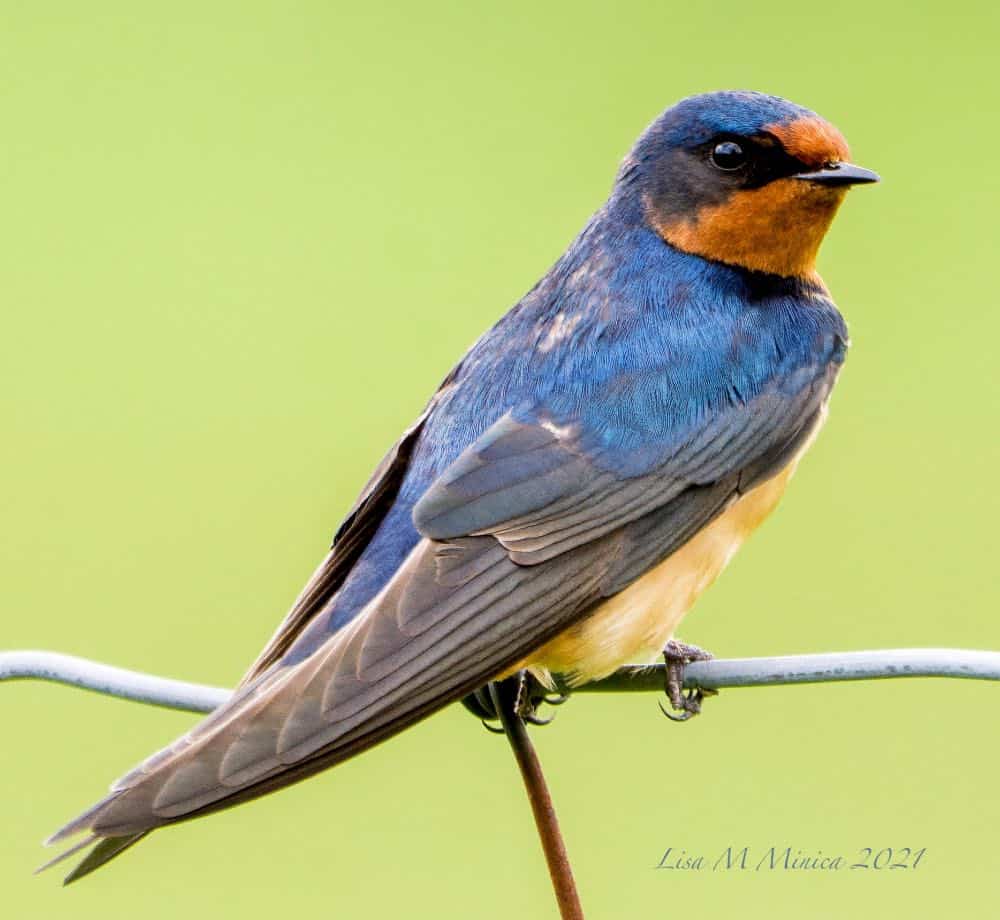
Appearance: 7″ long, steel blue glossy on top, chestnut forehead and throat, and rust-orange underparts. Long forked tail with a white base. The female’s coloring is lighter and the tail shorter.
Diet: Insects, preferably beetles, wasps, and flies. Drinks by skimming the surface of the water.
Feeder food: Not likely to visit a feeder.
Habitat: Open fields and pastures.
Nesting: A barn swallow typically nests in or on a manmade structure such as a barn. Builds nests of mud. 2 broods/season, 4-5 eggs per brood, eggs are white with brown markings, incubation from 13-17 days.
Migration: Barn swallows are migrators. In spring, they’ll migrate north into the US and Canada for breeding and to raise their young. When fall comes, they’ll head south to Mexico’s southern states. That said, they do maintain a year-round range in central Mexico where they remain for every season.
Range Map
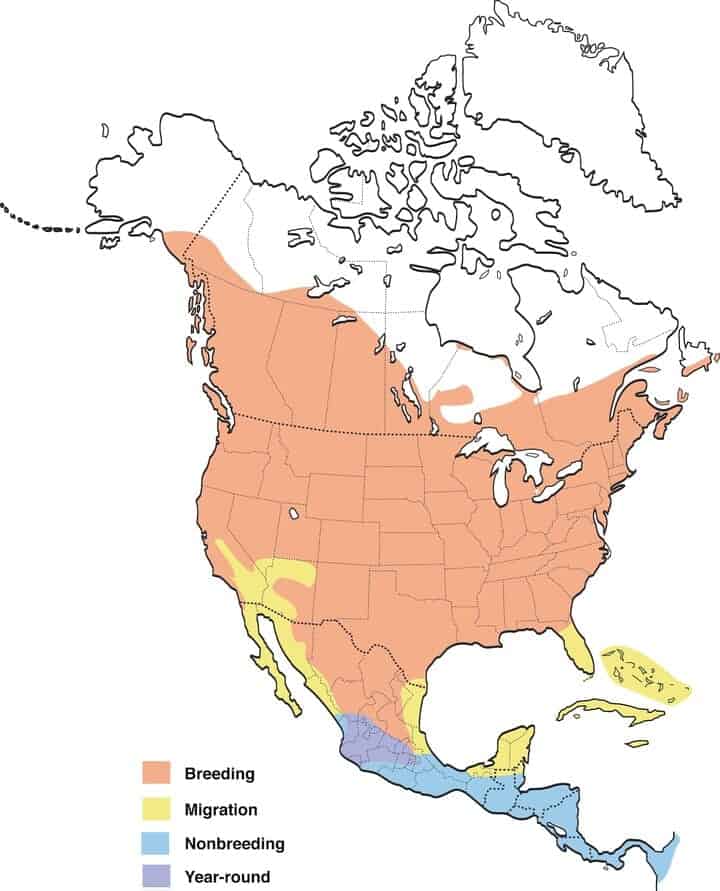
Belted Kingfisher
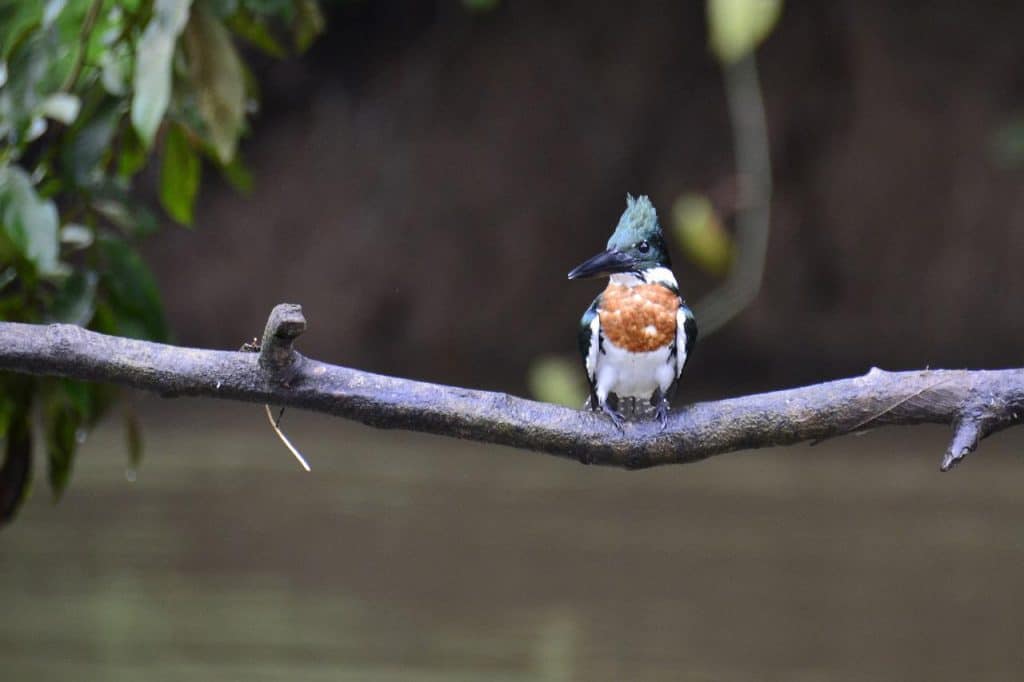
Appearance: The belted kingfisher is a large 13″ long bird with a large head, long bill, and stocky body. Blue/gray throughout with white ring around neck and white chest. The Female is the same but with an additional chestnut band on her chest.
Diet: Large 13″ long bird with a large head, long bill, and stocky body. Blue/gray throughout with white ring around neck and white chest. The Female is the same but with the additional chestnut band on the chest.
Feeder food: Unlikely to come to the feeder but often attracted to yards with streams or ponds.
Habitat: Near streams, rivers, ponds, lakes, and calm marine waters – especially unclouded water with little vegetation.
Nesting: Belted kingfishers dig burrows along the water’s edge for their nest. 1-2 broods/season, 5-8 eggs/brood – large white glossy eggs (1.5″ long), 22-24 days incubation.
Migration: Many but not all belted kingfishers are migrators. In spring, the migrators will head north into Montana, North Dakota, northern Minnesota, Canada, and Alaska to breed and raise their young. When fall comes the migrators head back south – as far south as Arizona, New Mexico, southern California, and Mexico.
Year-round range: All US states (except North Dakota and Arizona) and the pacific coast of Canada’s British Columbia.
Breeding range: While some stay in their year-round range, many others migrate north into Montana, North Dakota, northern Minnesota, Canada, and Alaska to breed and raise their young. When fall comes the migrators head back south – as far south as Arizona, New Mexico, and southern California.
Winter range: While many belted kingfishers migrate south for winter, just as many remain in their year-round range when the temperatures dip.
Range Map
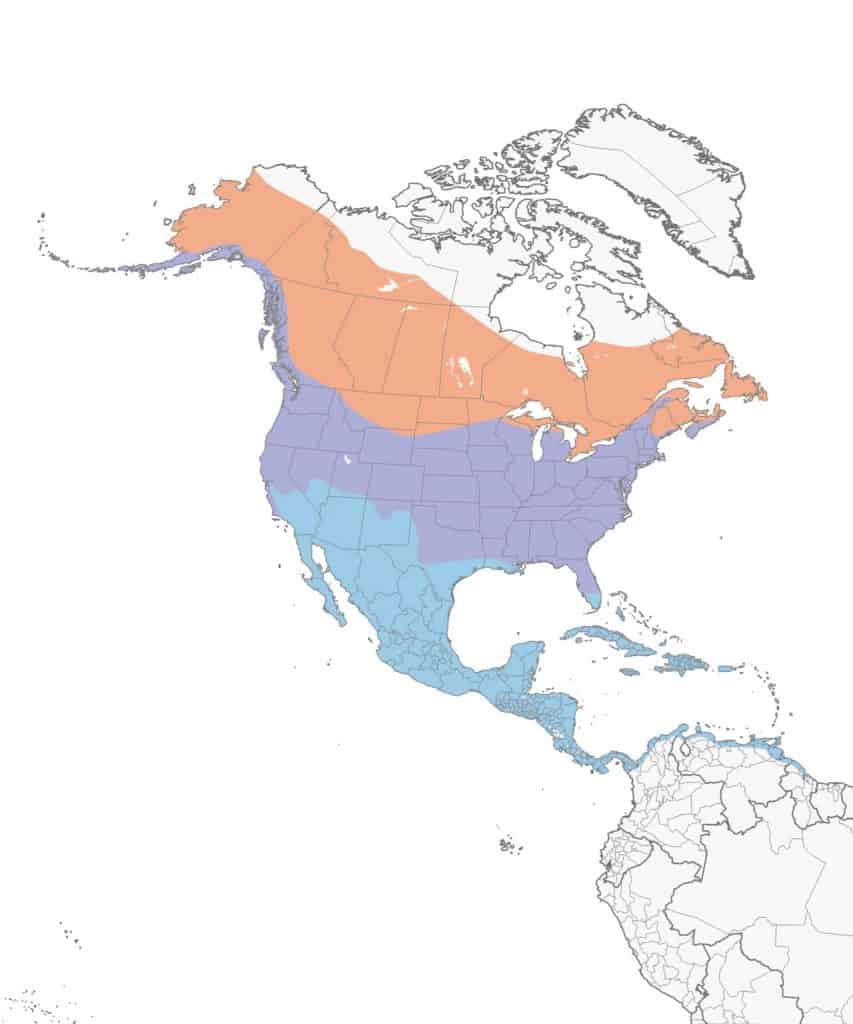
Black Throated Blue Warbler
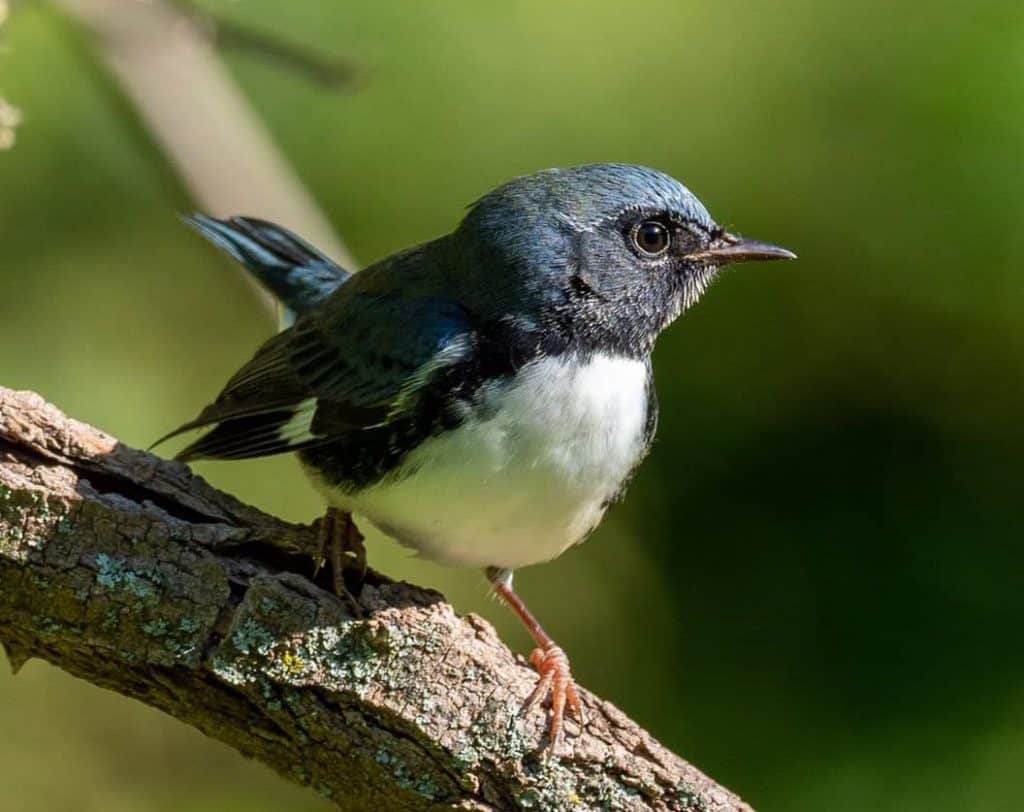
Appearance: Black-throated blue warblers are small birds about 5″ long, midnight/steel blue back, black throat, and a white belly
Diet: Insects and fruit.
Feeder food: Suet, peanut butter, and nectar.
Habitat: Prefer mature deciduous and mixed evergreen woodlands with plenty of thick shrubs.
Nesting: They build a cup-shaped nest in a shrub made of bark and spider webs. 1-3 broods/season, 2-5 eggs/brood, eggs are small .6″-.8″, creamy white and speckled. Incubation lasts for about 12-13 days.
Migration: Black-throated blue warblers are true migrators. They head north in spring to breed and raise their young. In the fall, they migrate south to winter in southern Florida and the Caribbean.
Breeding range: Northern Wisconsin, Northern Michigan, eastern Tennessee & Kentucky, West Virginia, Pennsylvania, Pennsylvania, the New England states, and Canada’s southern provinces of Ontario and Quebec.
Winter range: Southern Florida and the Caribbean islands.
Range Map
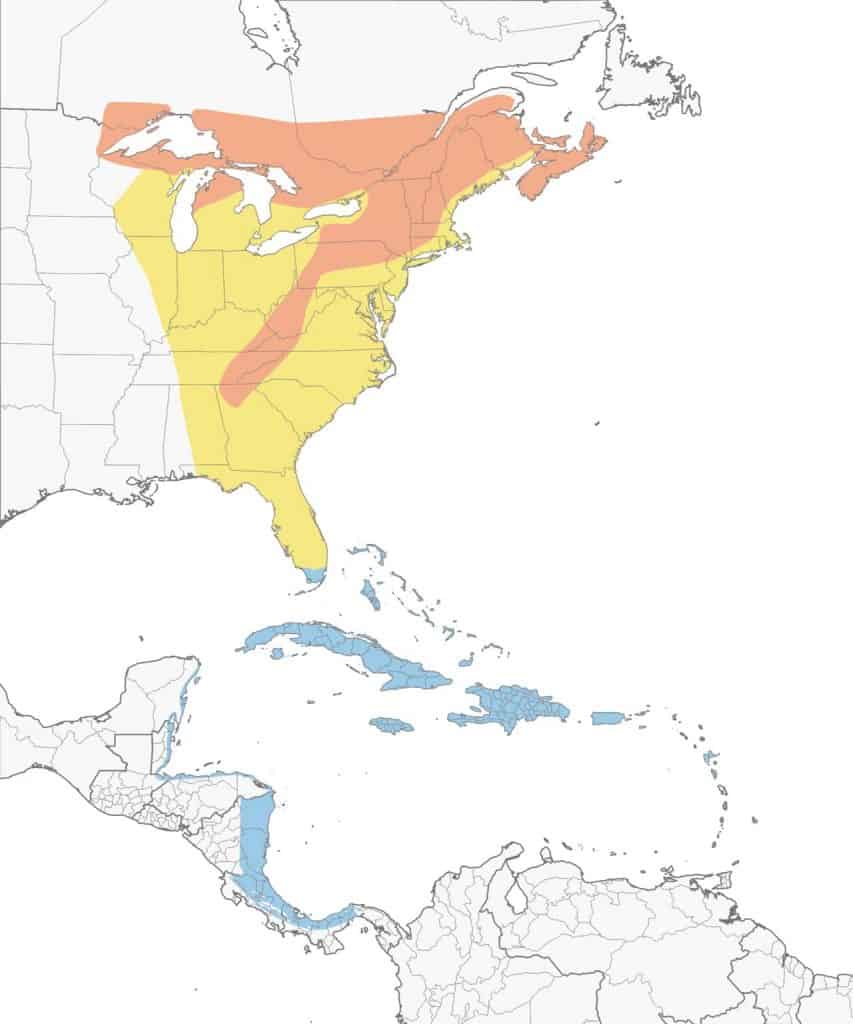
Blue Grosbeak
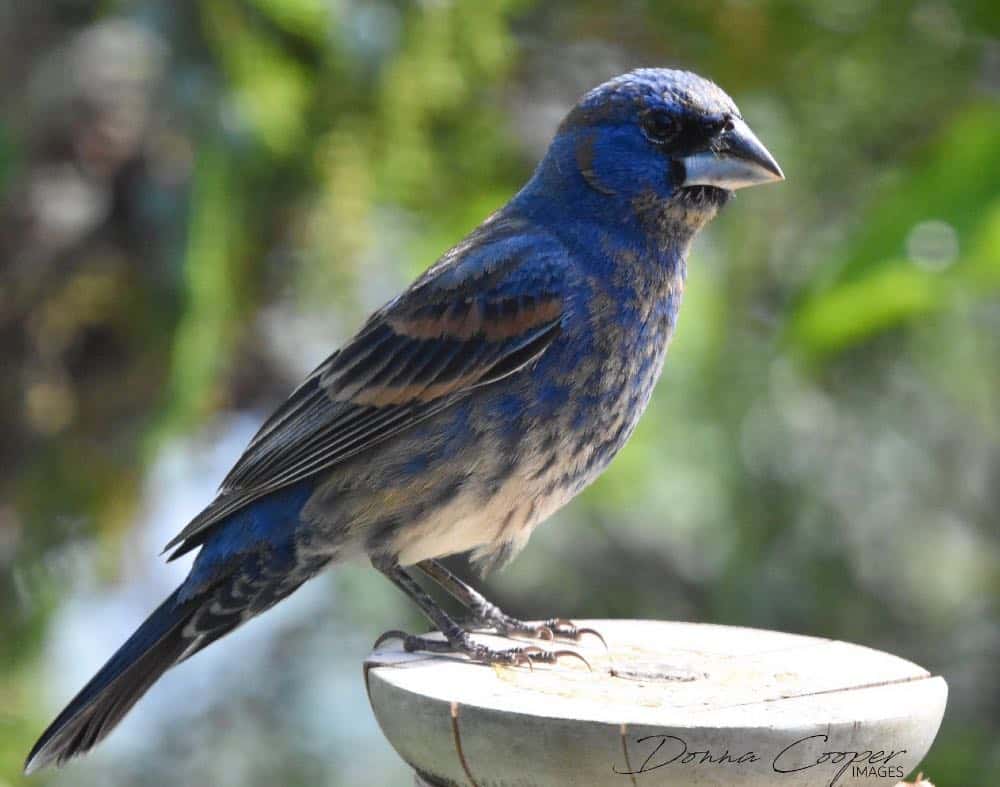
Appearance: Blue grosbeaks are medium birds about 8″ long, large, bright blue, with large silver bills, and chestnut wingbars. The female’s primary color is light cinnamon with darker-colored wings.
Diet: Insects, seeds, and grains.
Feeder food: Grain and birdseed.
Habitat: Thick shrubbery and areas with tall trees.
Nesting:
- Nest: Small cup-shaped nest of twigs and miscellaneous organic materials resting in low-lying trees, shrubs, and bushes.
- Brood: 1-2 broods/season
- Clutch: 3-5 eggs/brood
- Egg color: Pale blue to white with occasional brown spots
- Egg size: 0.8 inches by 0.7 inches
- Incubation: 12-13 days incubation.
Migration: Blue grosbeaks are migrators. In spring, they migrate north into the US to breed and raise their young. Then in the fall, they head back south for the winter. There is a small area in Mexico they call their year-round home. The birds in this area don’t typically migrate.
Year-round range: Parts of Mexico.
Breeding range: Southern half of the US as well as North Dakota, South Dakota, and Kansas.
Winter range: Mexico and the Caribbean islands.
Range Map
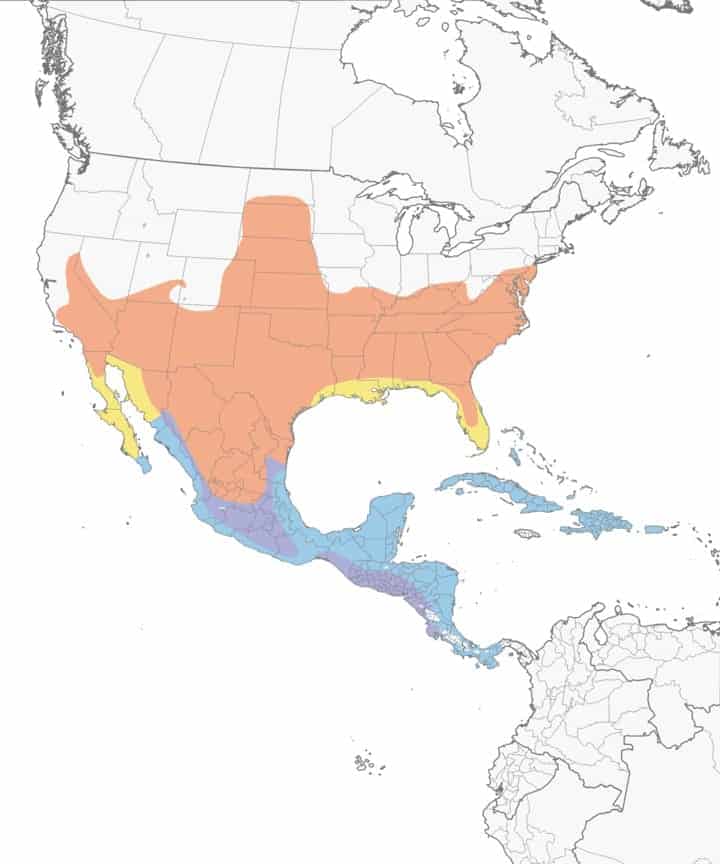
Blue Jay
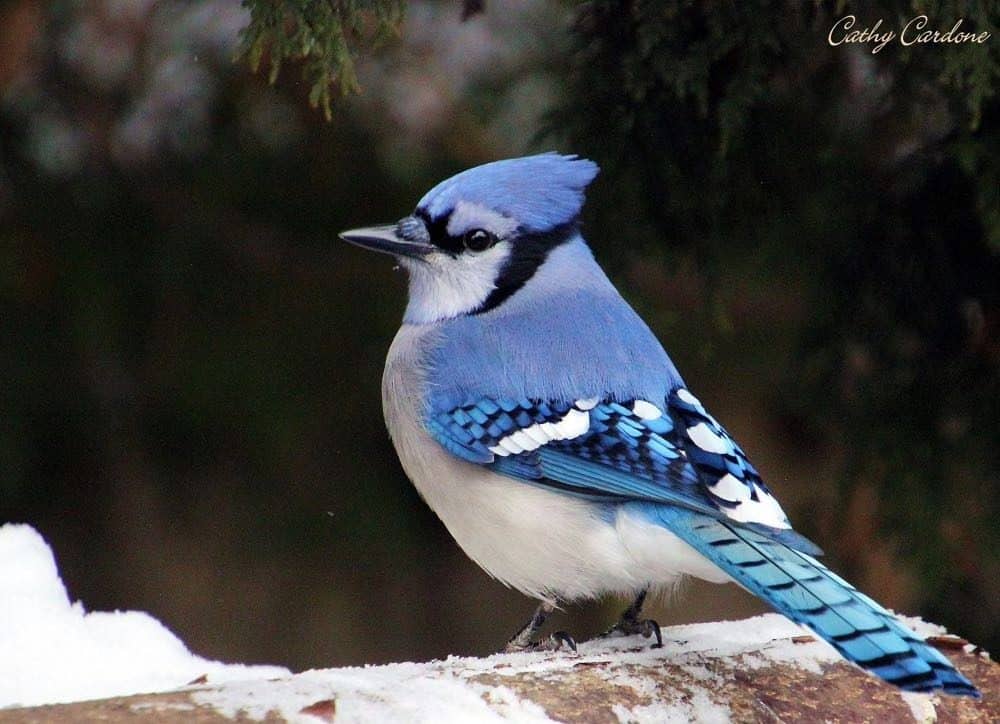
Appearance: Large bird 12″ long, medium blue & white body, blue crest (which he flattens at will), gray belly, and white face. White & blue wings with black spots. Females look the same.
Diet: Insects, fruit, seeds, nuts, other birds’ eggs, and nestlings.
Feeder food: Whole peanuts, sunflower seeds, and cracked corn.
Habitat: Forested areas with mixed tree types. Also common in suburbs and urban areas.
Nesting:
- Nest: bulky large nest made from twigs, bark, and mud resting on a tree branch about 5-50′ up.
- Broods: 1-2 broods/season,
- Clutch: 2-7 eggs/brood,
- Egg color: Pale blue to a light brown base color, and these eggs usually have brown or gray spots.
- Egg size: 1 inch by just under 1 inch
- Incubation: Both parents incubate the eggs for 17-18 days and the young fledge between 17-21 days.
Migration: In general, blue jays are not migrators. They remain in their year-round range for all 4 seasons – even during the breeding season. While they may move within their year-round range, they do not regularly head north for breeding and south for winter as some species do. That said, in rare cases, some will head west of their year-round range for the winter.
Range Map
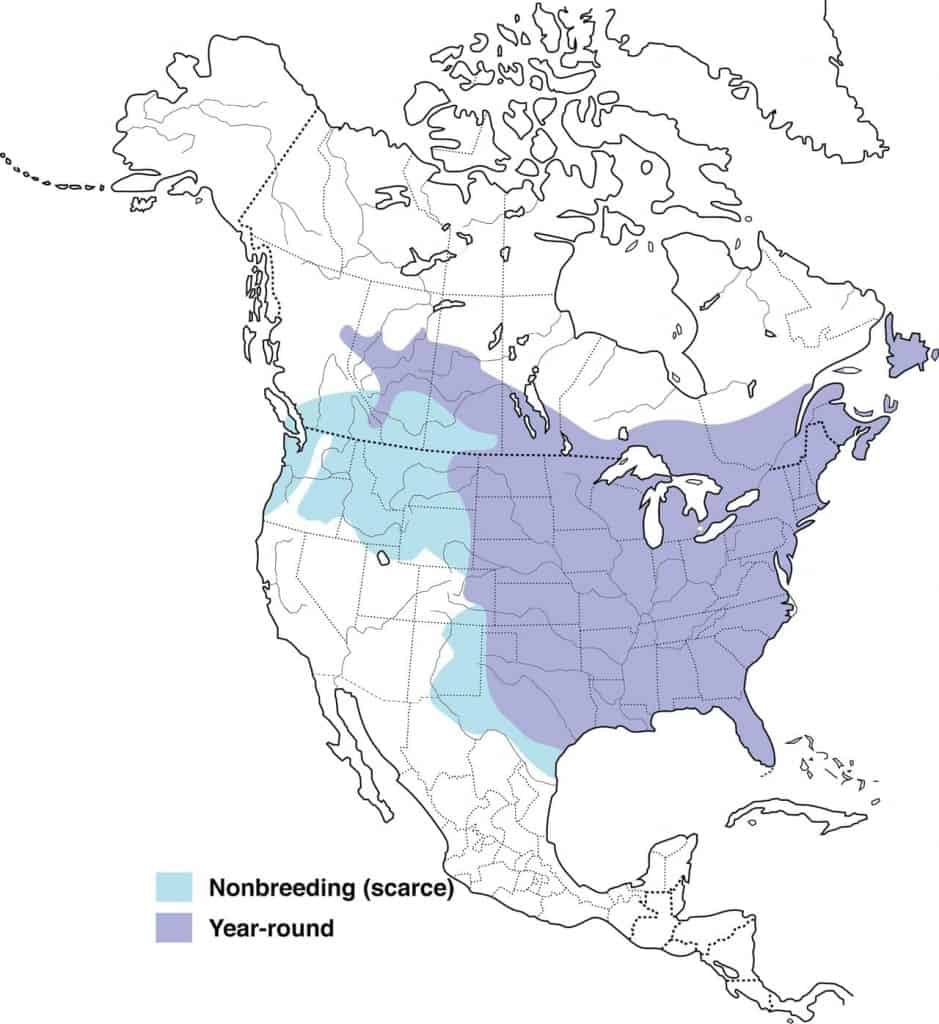
Blue-Gray Gnatcatcher
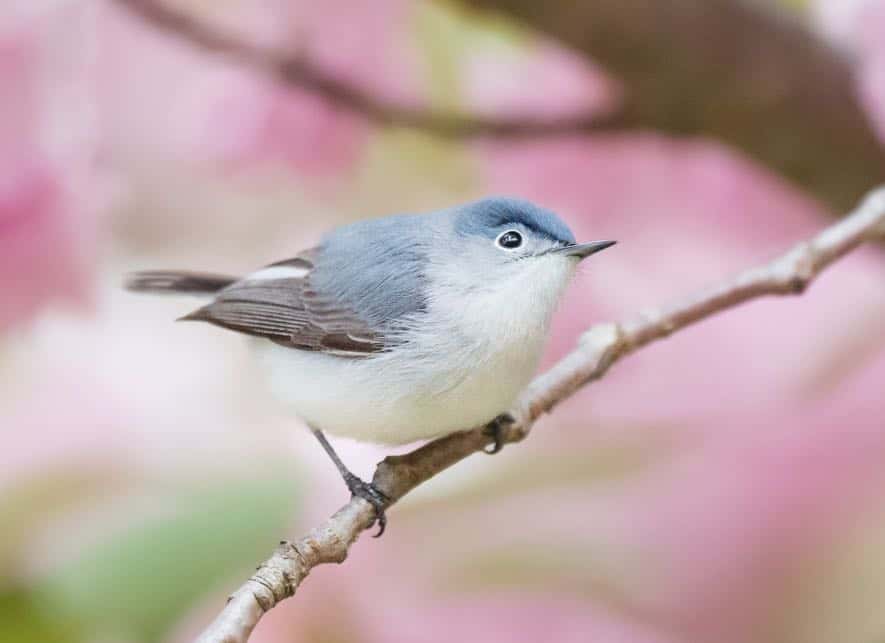
Appearance: Blue-gray gnatcatchers are tiny birds 4.25″ long, with soft blue/gray upperparts, white eye-rings, white underparts, and long black long tails with white under. The females are the same. The breeding male is accented with narrow black eyebrows.
Diet: Insects and spiders.
Feeder food: Unlikely to visit the feeder.
Habitat: Deciduous forested areas.
Nesting:
- Nest: Tidy cup-shaped nest of natural fibers, bark, and spiderweb about 3-80′ high in a tree or shrub.
- Broods: 1-2 broods/season
- Clutch: 3-5 eggs/brood
- Egg color: Pale blue with red/brown spots.
- Egg size: 0.5 – 0.6 inches by 0.4 – 0.5 inches
- Incubation: 11-15 days and the young fledge at about 10-15 days.
Migration: While many blue-gray gnatcatchers remain in their year-round range during the spring & summer, most migrate north into the US for breeding and to raise their young. The migrators then head back south in the fall and return to their year-round range or even further south along the Mexican Pacific coast, southern Florida, and the Caribbean islands to spend winter.
Year-round range: The southernmost part of these US states: California, Arizona, New Mexico, Texas, Louisiana, Georgia, Mississippi, Alabama, Florida, South Carolina, North Carolina, and Virginia.
Breeding range: Eastern half of the US as well as California, Nevada, Utah, Arizona, Colorado, New Mexico, Texas, Kansa, and Oklahoma.
Winter range: Southern California, southwest Arizona, along the Pacific coast of Mexico, the southernmost tip of Florida, and the Caribbean islands.
Range Map
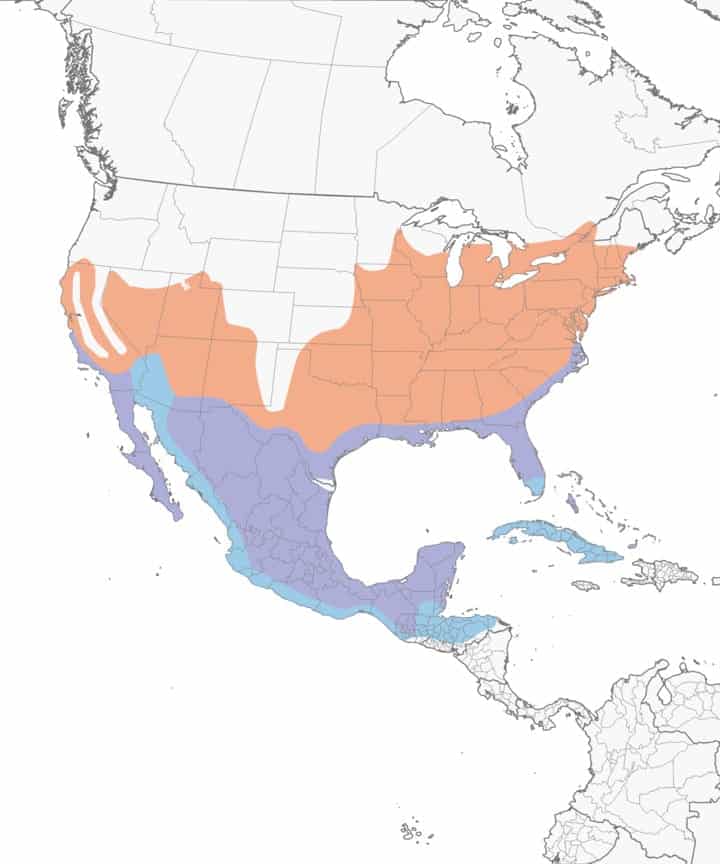
California Scrub-Jay
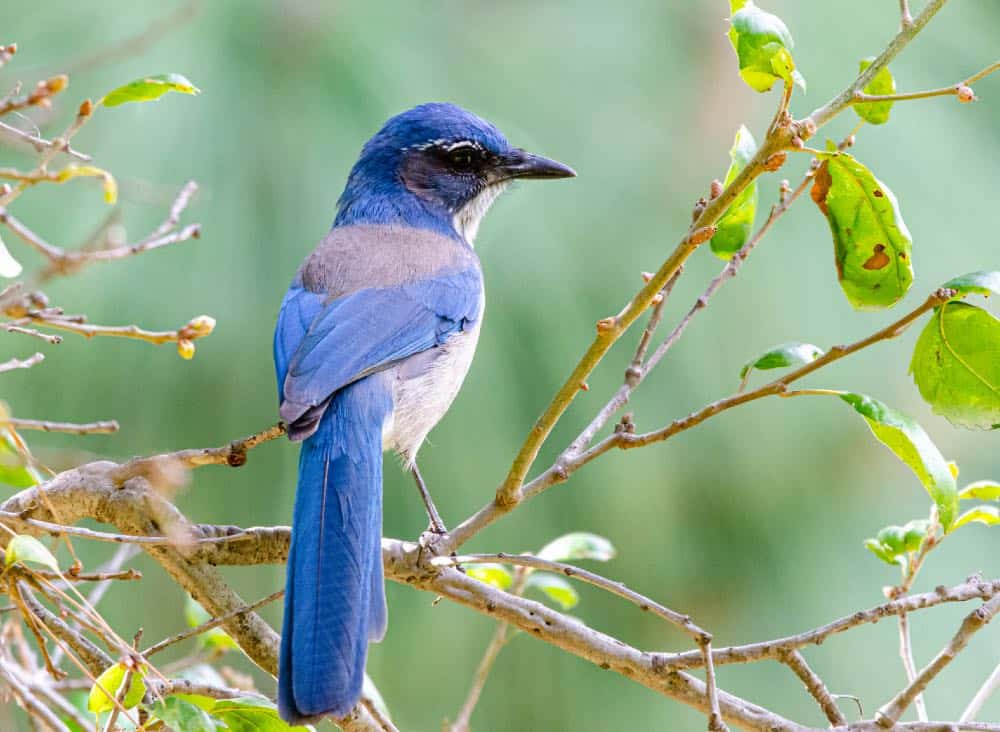
Appearance: Large bird 11″ long, slender, shades of bright azure blue and gray, brown patch on the back, white underparts, blue necklace, and long tail. Females look the same.
Diet: Insects, nuts (especially acorns), seeds, fruit, other birds’ eggs and nestlings, and small animals.
Feeder Food: Whole peanuts, sunflower seeds, and suet.
Habitat: Along the edges of the west coast including from Baja, Mexico to the southernmost part of British Columbia. Prefer open areas with ample trees and scrubs even within suburban and urban areas.
Nesting: Large and bulky open-cup nest of twigs and bark, in a tree or bush about 3-10′ up. 2-3 eggs/brood, incubated for 15-17 days, and young fledge between 18-23 days. Eggs are 1-1.5″ long, pale green blotched with olive, or pale gray spotted with brown.
Range Map
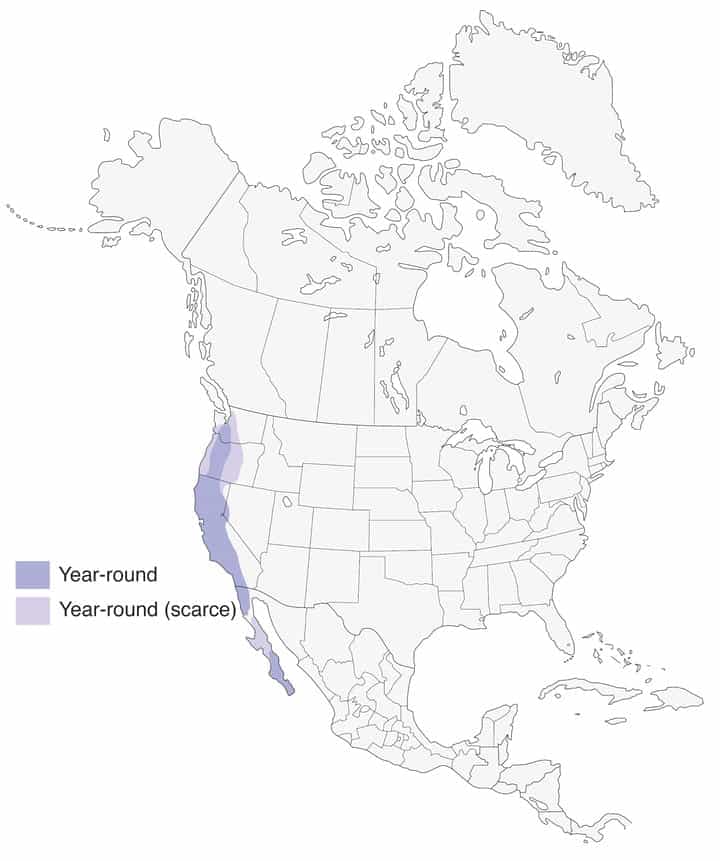
Cerulean Warbler
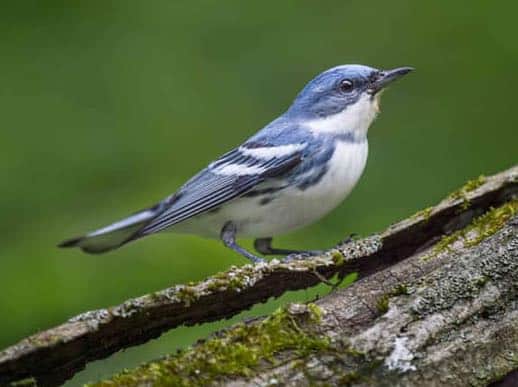
Appearance: Cerulean warblers are small 4.3″ long birds with sky-blue above, white wing bars, darker blue streaks on the back, white belly, steel/blue neck band & stripes on the sides. The females are light blue/green above, with soft yellow bellies, brown wings, and a bit of white under the eye.
Diet: Insects and plants.
Feeder food: Unlikely to visit the feeder.
Habitat: Deciduous forests with mature tall trees.
Nesting: Cup-shaped nests of twigs, grass, and spiderwebs placed in trees 16-115′ up. 1 brood/season, 1-5 eggs/brood, eggs are .6-.8″ long, gray/green, and speckled with brown, incubation lasts 11-12 days.
Migration: Cerulean warblers are migrators. They head north into the midwest and northeast states for spring & summer then head south to South America for the winter.
Breeding range: Eastern Minnesota, the southern half of Wisconsin & Michigan, Missouri, Illinois, Indiana, Ohio, Pennsylvania, New York, Kentucky, Tennessee, southern New York, and the far southern edge of Canada’s Ontario.
Winter range: South America.
Range Map
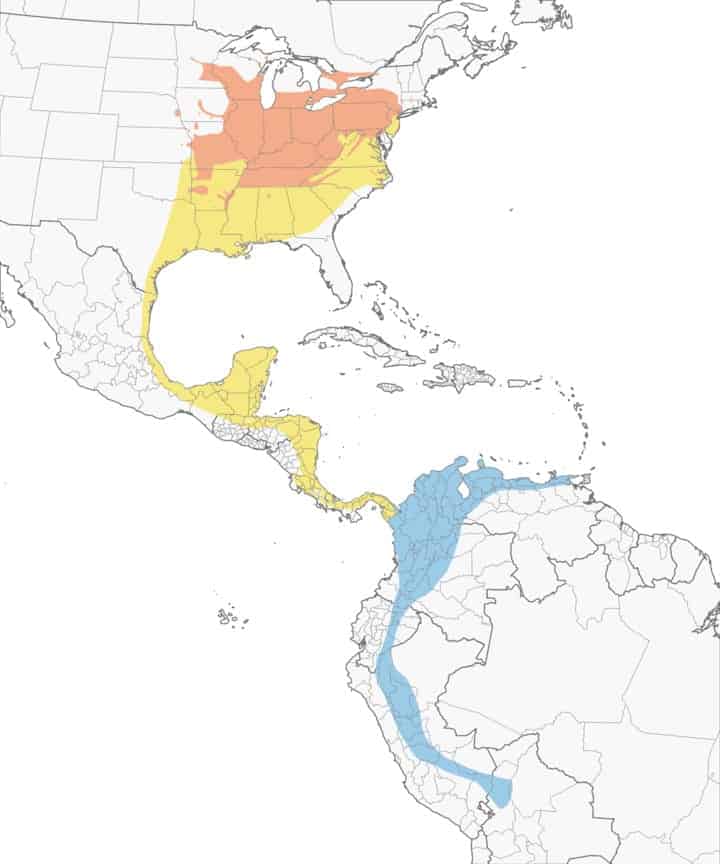
Common Grackle
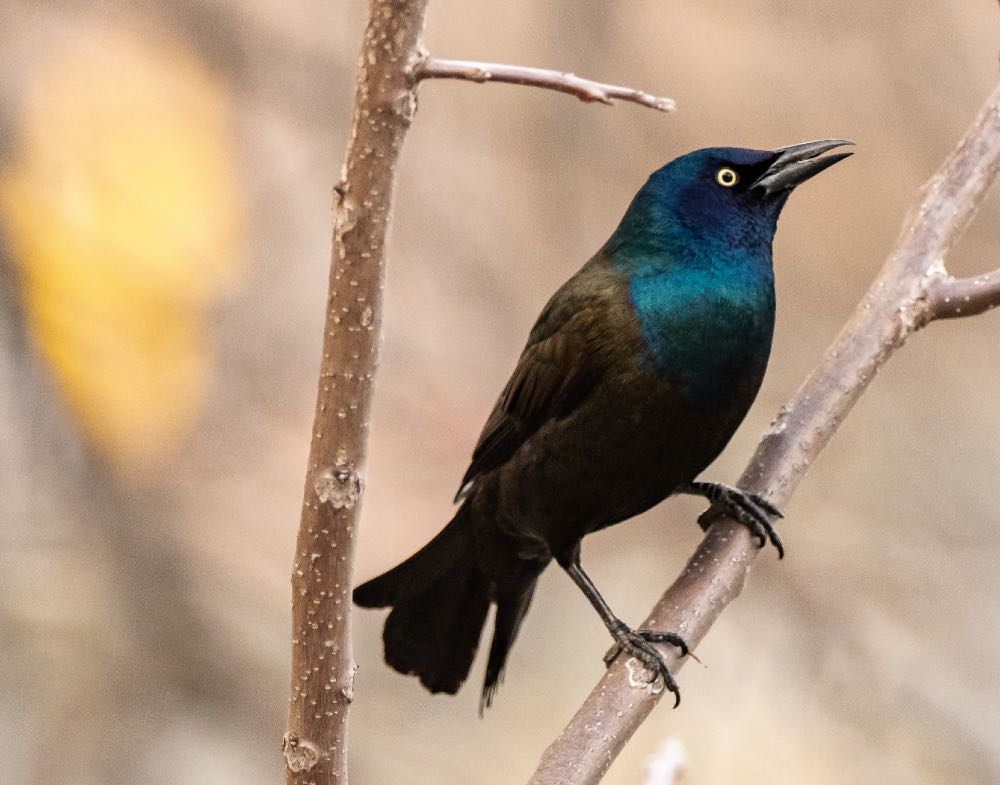
Appearance: The common grackle is a large bird about 12.5″ long bird with iridescent blue purple and bronze. Their eyes are yellow and they have long flared tails. The female is similar with less vibrant coloring (browner) and a shorter tail.
Diet: Insects, grains, seeds, fruit, scavenged garbage.
Feeder food: Sunflower seeds, black-oil sunflower seeds.
Habitat: Fields with scattered trees, open woodlands, farmlands, and marshes. Common in suburban yards.
Nesting: Bulky cup-shaped nest of twigs placed 3-20′ high in a conifer tree. 3-5 eggs incubated for 12-15 days. Young fledge at about 12-15 days.
Migration: Common grackles are migrators. While many remain in their year-round range all four seasons, many head north in spring (as far north as Canada’s Northwest Territories) to breed and raise their young. Then in the fall, they head back south into their year-round range. A small part of the population pushes further southwest of Texas.
Year-round range: Nebraska and the US states south and east of it. US states
Breeding range: Montana, Idaho, Wyoming, Colorado, New Mexico, North Dakota, South Dakota, Kansas, western Kansas, Minnesota, Wisconsin, Michigan, the New England states, and all Canadian provinces (except for Nunavut and barely British Columbia).
Winter range: Southwest edge of their Texas year-round range.
Range Map
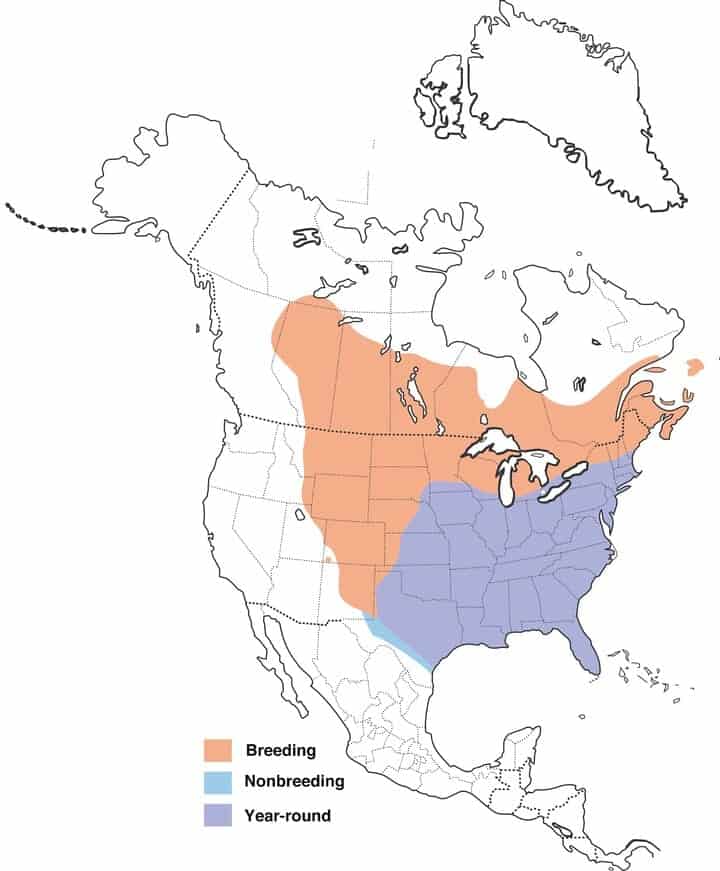
Eastern Bluebird
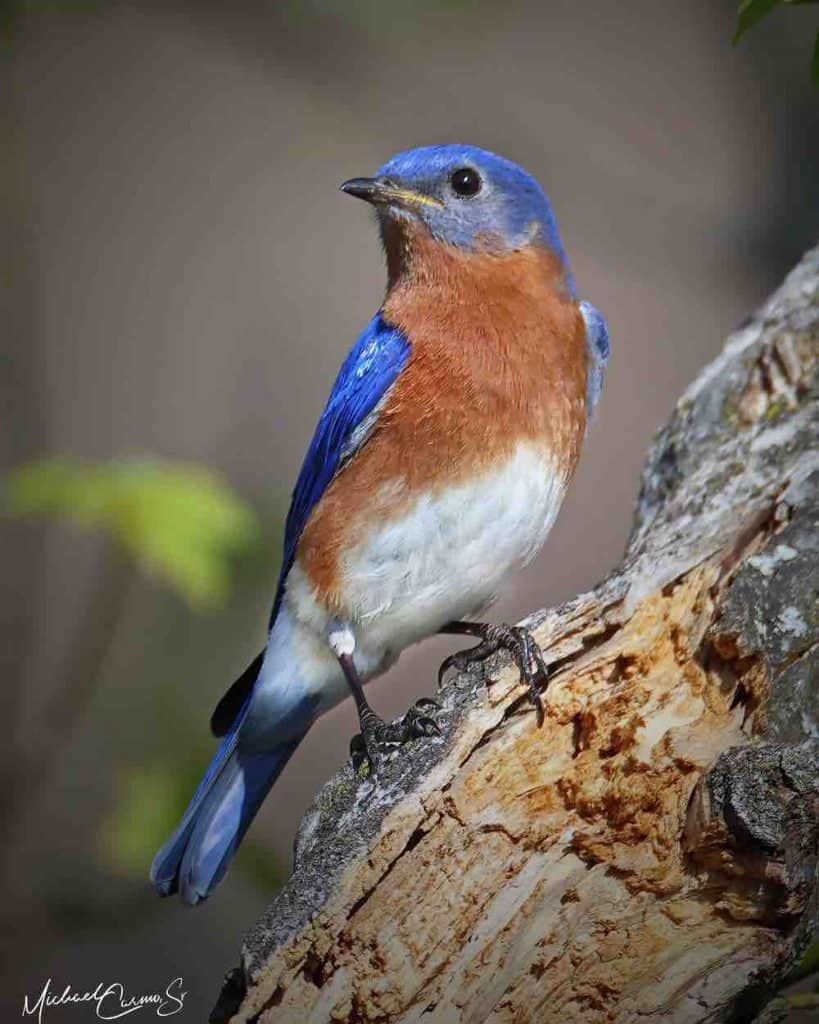
Appearance: Eastern bluebirds are small birds about 7″ long, royal blue, orange throat & breast, white belly & undertail. Female is similar but with more muted colors
Diet: Insects & spiders in spring/summer. Small fruit in Fall/Winter.
Feeder food: Suet, sunflower seeds, dried fruit, jelly.
Habitat: Wide-open spaces, fields, meadows.
Nesting:
- Nest: Cavity nesters. The male bluebird determines the nest site (an old woodpecker hole in a tree or manmade nestbox), but the female is the one who builds the nest. She keeps the nest for multiple broods.
- Brood: 2-7 broods/season
- Clutch: 4-5 eggs/brood
- Egg color: Pale blue eggs (sometimes white) with no blemishes or discoloration.
- Egg size: 0.9 inches by 0.8 inches
- Incubation: 11-19 days
Migration: Some eastern bluebirds are migrators. While many remain in their year-round range all year long, some migrate north for breeding and raising their young then head south in winter back into the year-round range or further west into Colorado, New Mexico, and western Texas.
Year-round range: The US states south and east of Nebraska, Mexico, and Central America.
Breeding range: Northwest Nebraska, South Dakota, North Dakota, Minnesota, the northern half of Wisconsin & Michigan, New Hampshire, Maine, and the southern part of these Canadian provinces: Saskatchewan, Manitoba, Ontario, and Quebec.
Winter range: Eastern Colorado, New Mexico, western Texas, and northeast Mexico.
Range Map
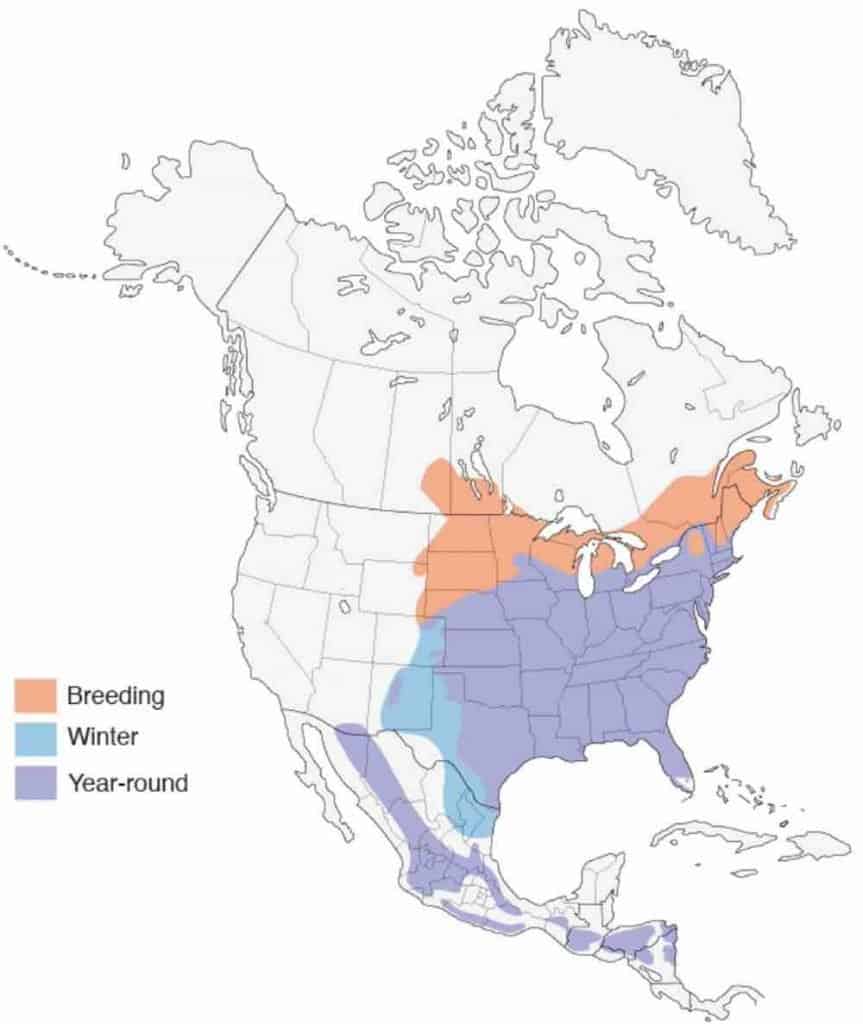
Florida Scrub-Jay
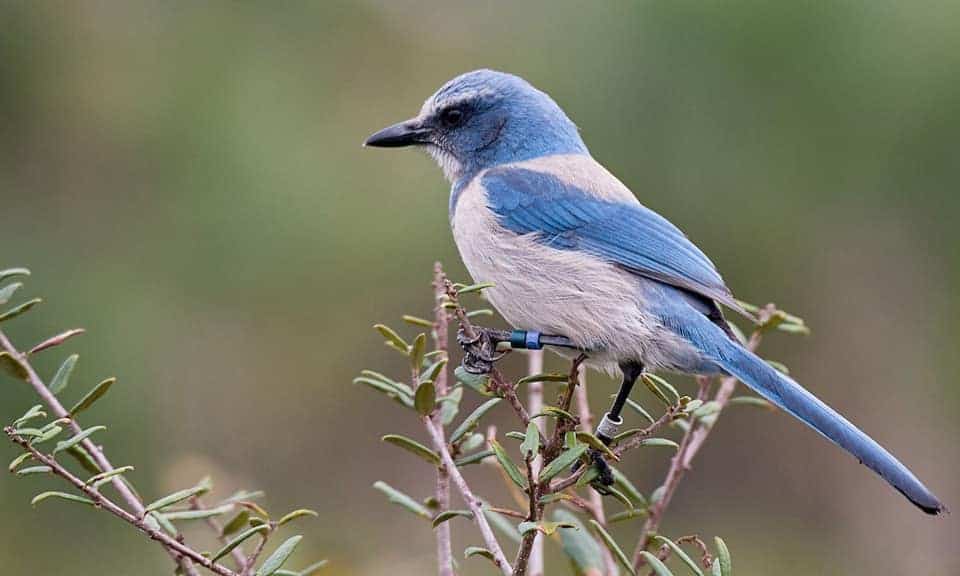
| Appearance | About 10″ long, large blue bird, light gray back and belly, swipes of white through forehead, and very long tail. Female is similar. |
| Diet | Varied diet of insects, nuts (especially acorns), berries, small snakes, mice, and lizards. |
| Feeder Food | Whole peanuts. |
| Habitat | Low-growing scrub oak exclusively in Florida. |
| Nesting | Cup-shaped nest of twigs and fibers located at the edges of scrubbed areas. 1-2 broods/season, 1-6 eggs/brood, eggs are about 1″ long, green with brown spots, 16-21 day incubation and young fledge at about 12-25 days. |
Range Map
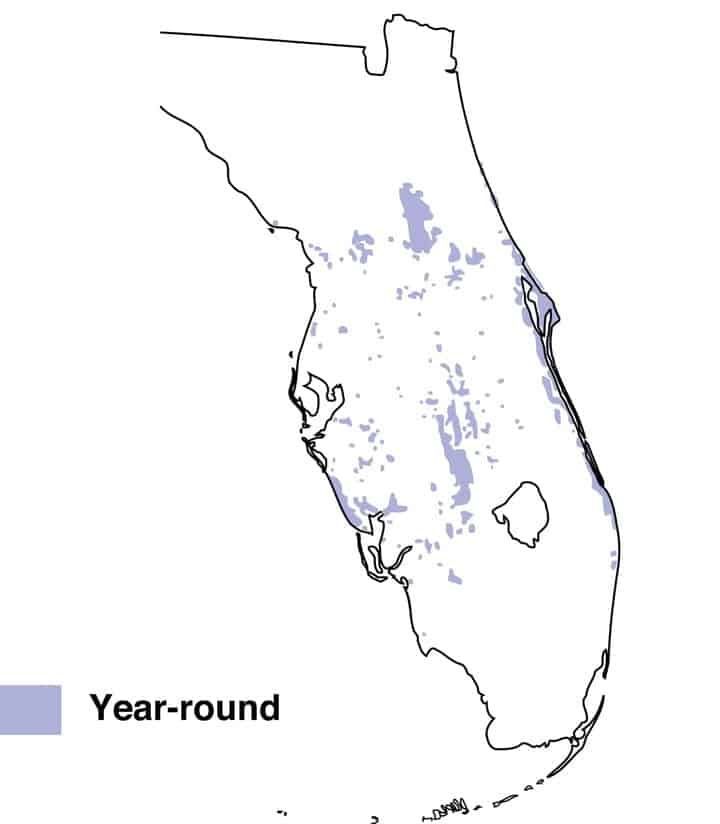
Indigo Bunting
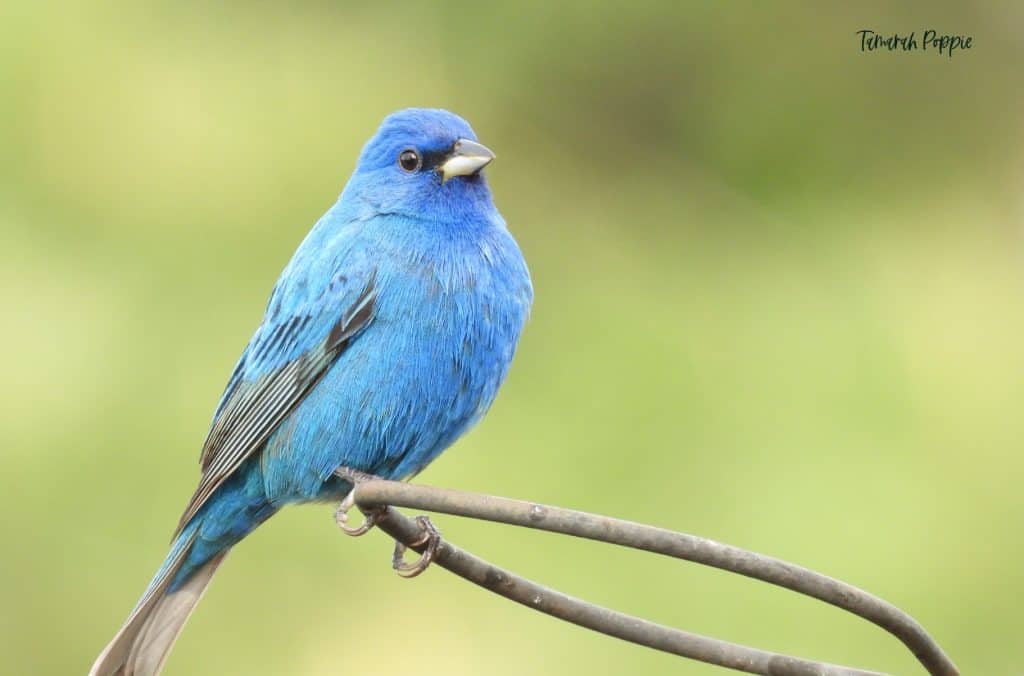
Appearance: Brushy fields, on weedy plants, scrub, and along the edges of the woods. Also in clearings within deciduous woods and edges of swamps.
Diet: Small seeds, insects, and fruits.
Feeder Food: Although not a regular at the feeder you may entice them with nyjer/thistle and white millet seeds.
Habitat: Brushy fields, on weedy plants, scrub, and along the edges of the woods. Also in clearings within deciduous woods, and edges of swamps.
Nesting: Cup-shaped nest in shrubs or trees 3′ high. Shrubs or trees 3′ high. 1-3 broods/season, 3-4 eggs/brood, eggs are white with few brown spots.
Range Map
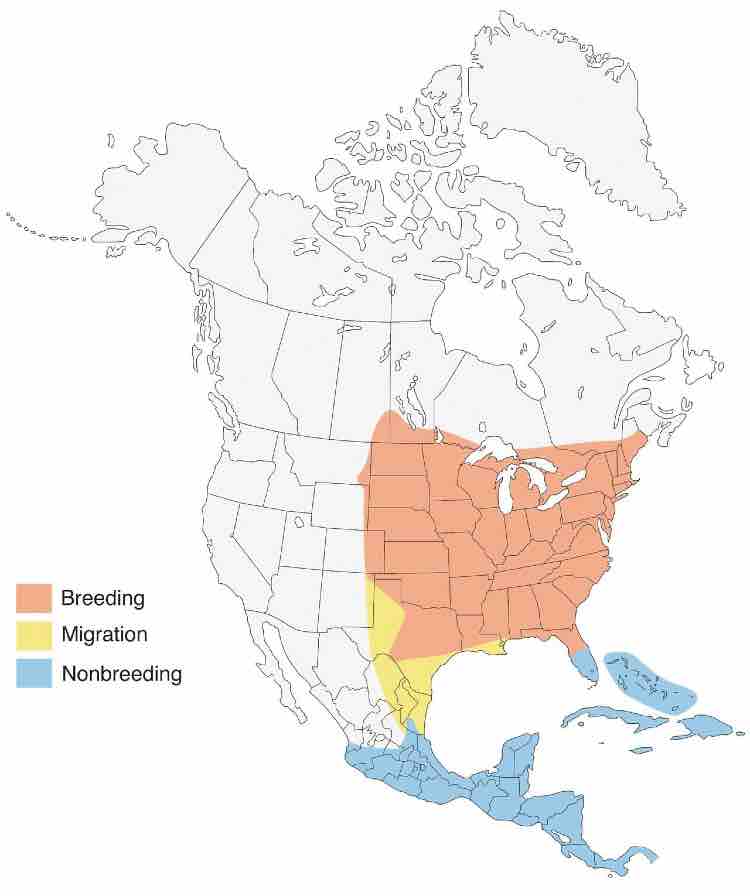
For more detail about the Indigo Bunting such as its mating & nesting, how to attract them to your yard, and more: check out Proven Ways to Attract Indigo Buntings.
Island Scrub-Jay
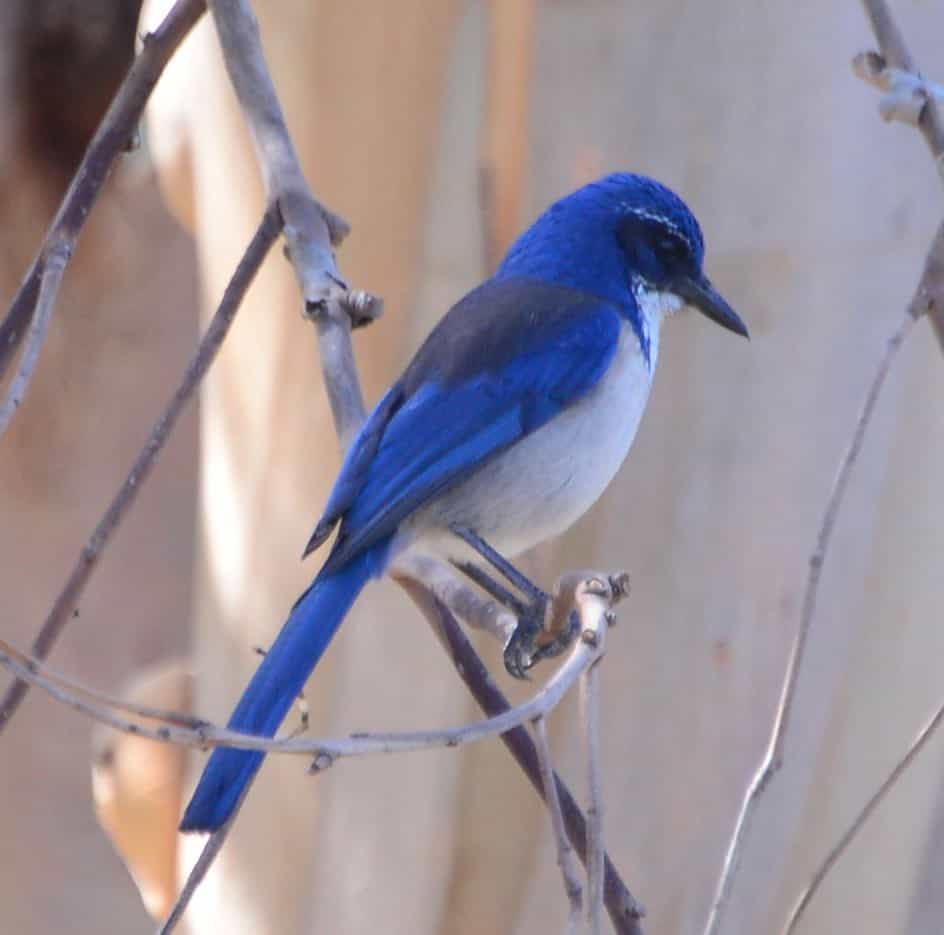
| Appearance | 13″ long, large vibrant blue bird, dark gray back and mask, white throat, light gray belly, large bill, and long tail. Female is similar. |
| Diet | Across, insects, spiders, snakes, lizards, mice, and other birds’ eggs and nestlings. |
| Feeder Food | N/A – Only 2 people inhabit the island. |
| Habitat | Found exclusively on Santa Cruz Island, California. |
| Nesting | Built with sticks, twigs, and roots in dense bushes and trees. 2-5 eggs/brood, incubation is about 20 days. |
Range Map
Found exclusively on Santa Cruz Island, California.
Lazuli Bunting
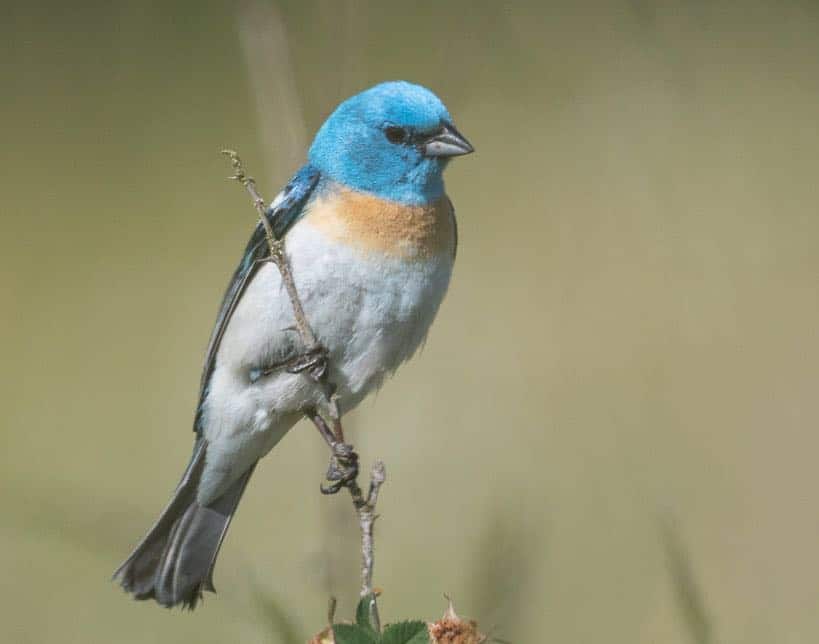
Appearance: Small bird 5-6″ long, brilliant blue on top, soft orange-cinnamon color chest, white belly and patch on the shoulder, cone-shaped bill, and slightly flat forehead.
Diet: Insects, fruits, and grasses.
Feeder Food: White proso millet, sunflower seeds, or nyjer thistle seeds.
Habitat: Open woodlands, brushy hillsides, thickets, and backyards throughout the West.
Nesting: Cup-shaped nest of bark, twigs, and leaves nestled in a shrub about 3′ up. They have 1-2 broods/season, 3-4 eggs/brood, and eggs are .7-.8″ long and pale blue to faint green/blue or white. 11-14 days incubation period.
Range Map
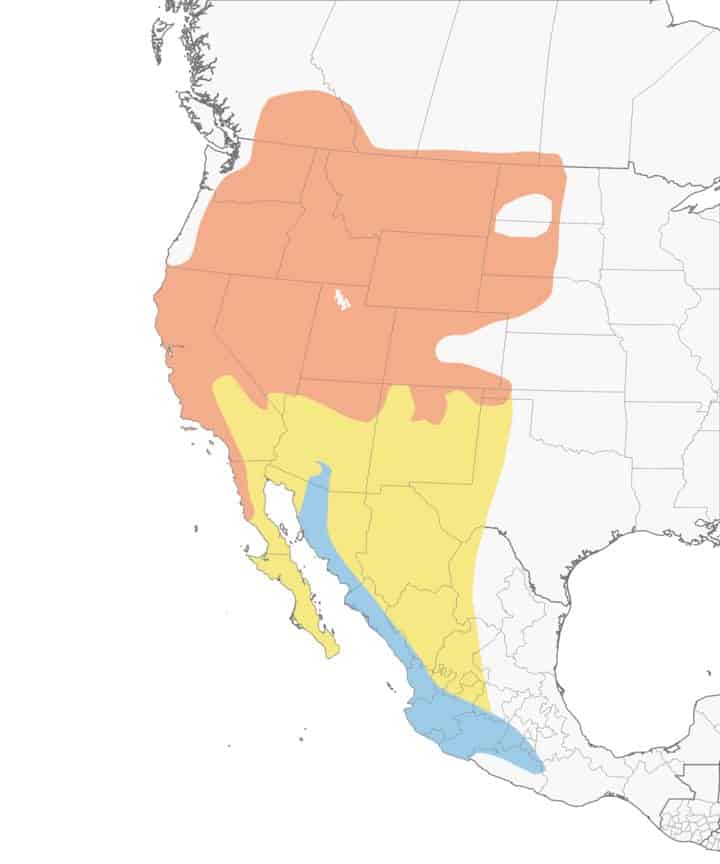
Mexican Jay
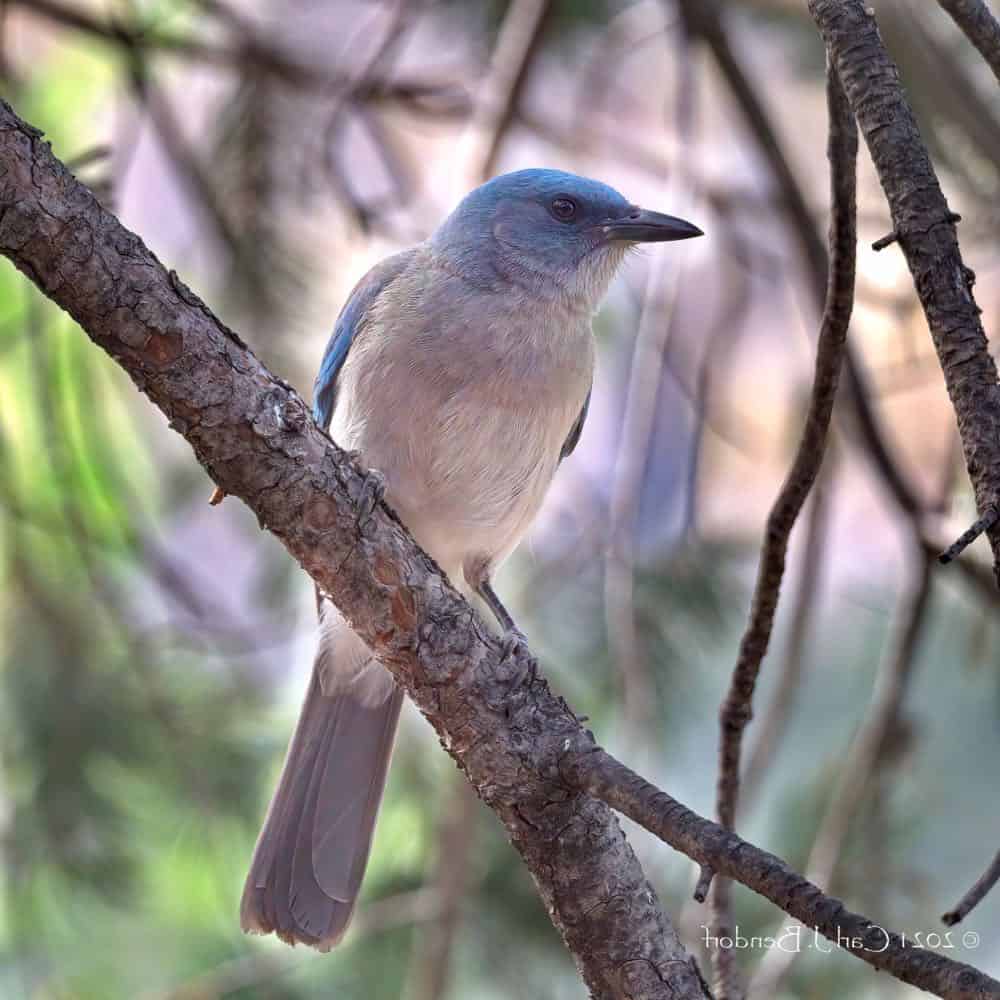
| Appearance | 11.5″ long, large blue bird with gray/blue back, soft white underparts and long tail. |
| Diet | Acorns, pinyon nuts, insects, spiders and lizards. |
| Feeder Food | N/A |
| Habitat | Open woodlands near pinyon and oak trees. |
| Nesting | Cup-shaped nest of twigs located tree. 1-6 eggs, eggs are green with dark markings but some have no markings. |
Range Map
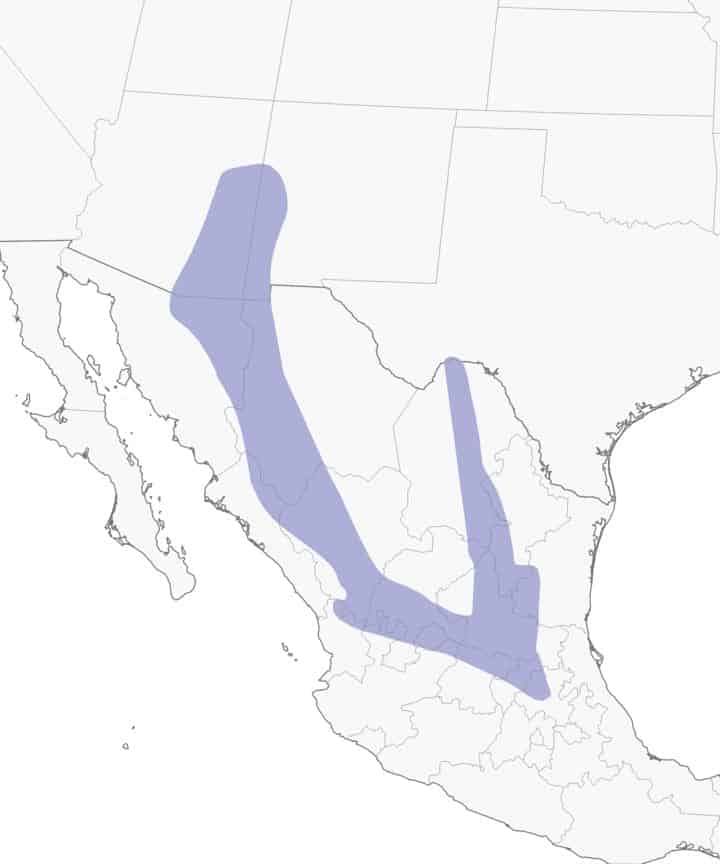
Mountain Bluebird
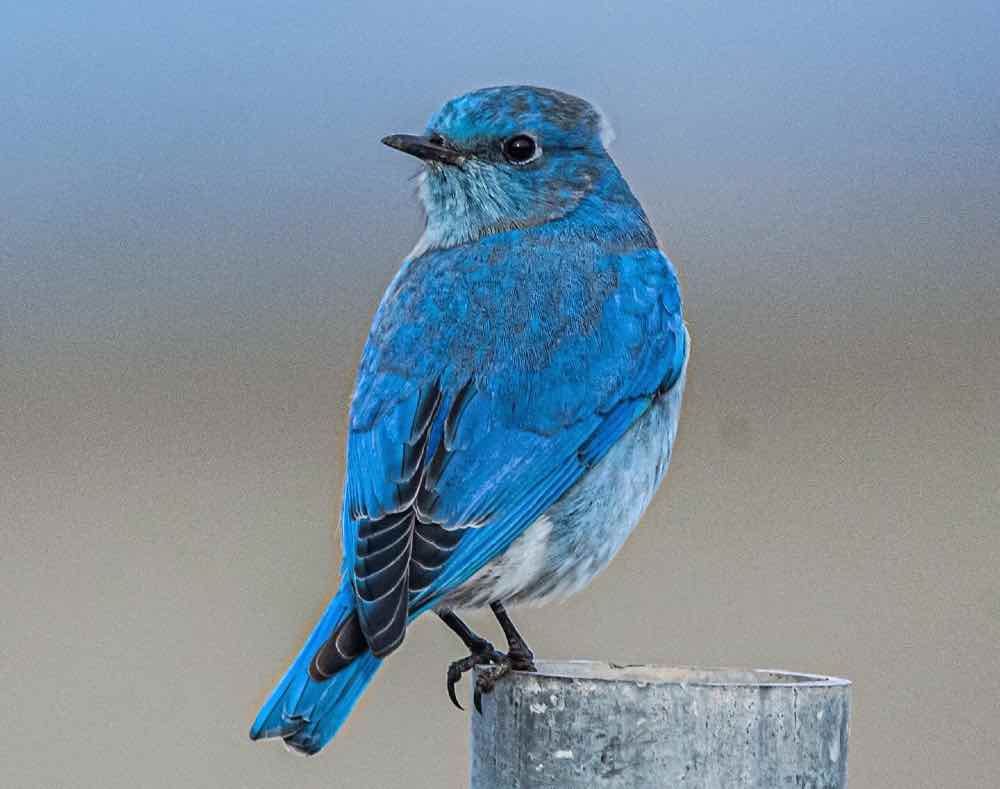
Appearance: Small bird about 7″ long. Sky-blue color, darker blue wings and tail, lighter shades of below underneath, white undertail with black wing tips, and straight thin bill. Females are gray/brown with a bit of soft blue on their wings and tail.
Diet: Insects, fruit, and seeds.
Feeder Food: Unlikely to visit a feeder.
Habitat: Open woodlands, fields, prairies.
Nesting: Cavity nesters – will use an old woodpecker hole or manmade nesting box.
Brood: 1-2 broods/season
Clutch: 4-8 eggs/brood
Egg size: 1″ x .8″
Egg color: Pale blue to bluish-white (rarely pure white)
Incubation: 18-21 days
Range Map
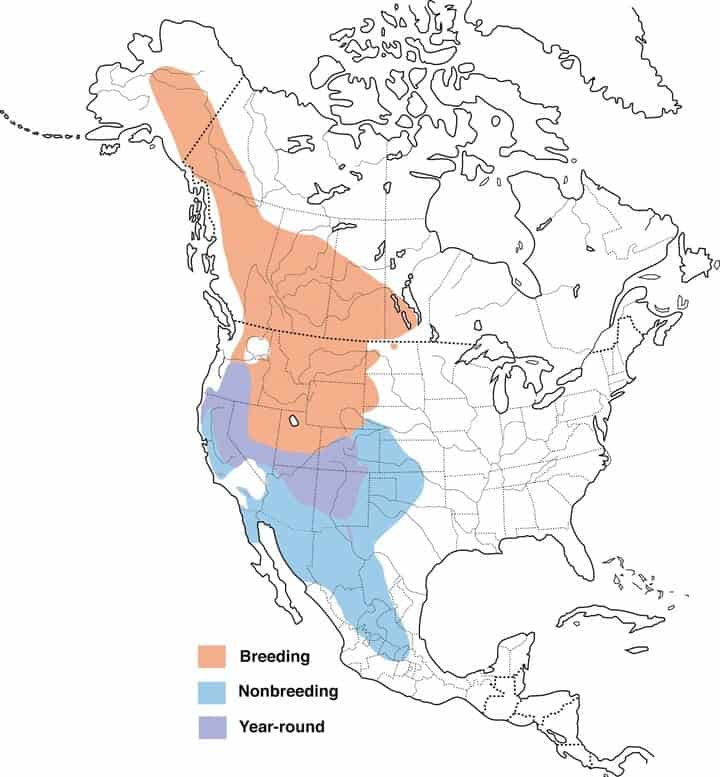
Northern Parula
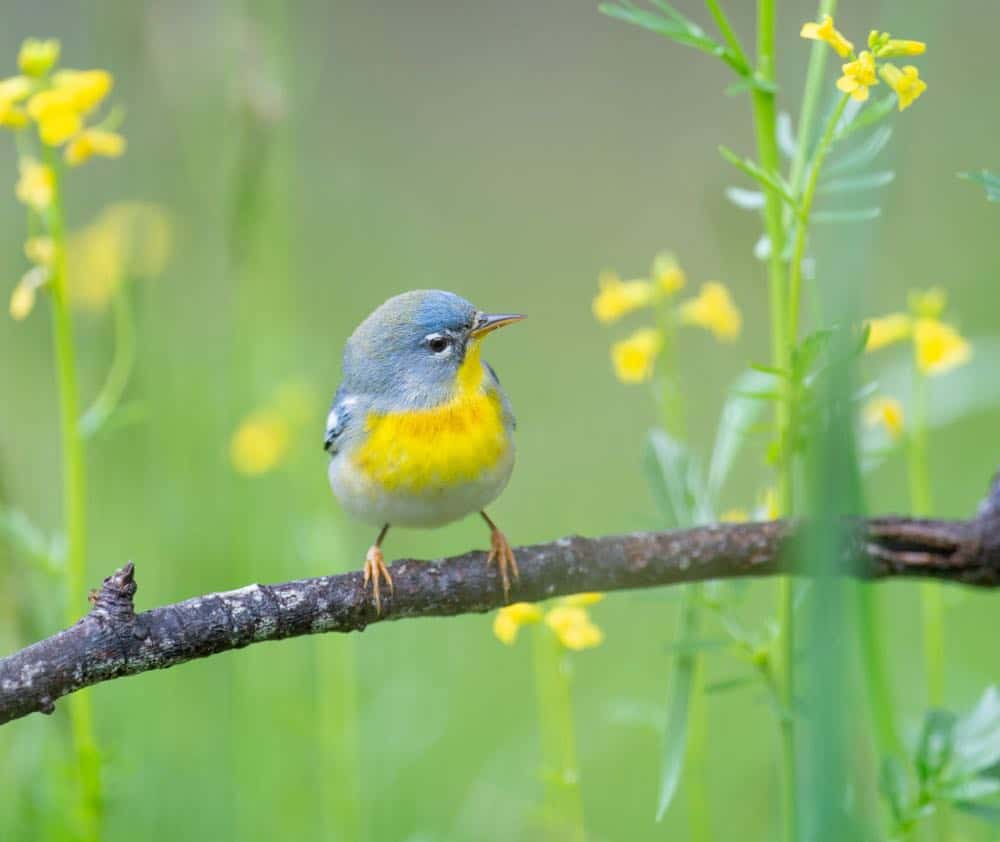
Appearance: Northern parula is a small bird about 4.5″ long, blue/gray with a yellow throat and back patch, bluish-gray overall with a yellow-green patch on the back, a brown band on the lower, and white strips above and below each eye. Females are similar but more muted colors. neck, and 2 white wing bars.
Diet: Spiders, insects, berries, seeds, nectar.
Feeder food: Unlikely to visit a feeder.
Habitat: Prefer forested areas especially when water is present (streams, marshes) and in the lowland where moss is present.
Nesting: Nests are built in mossy vegetation as high up as 100′ at the end of a branch. 1-2 broods/season, 2-7 eggs/brood, eggs are about .65″ long, white with red/brown/purple speckles, and incubation lasts about 12-14 days.
Migration: Northern parulas are migrators. In the spring, they migrate north to breed and raise their young. Then in the fall, they migrate south for the winter.
Breeding range: The US states south and east of Kansas, northern Minnesota, Wisconsin, & Michigan, Pennsylvania, New York, New England, and the southern parts of Canadian provinces Manitoba, Ontario, and Quebec.
Winter range: Southern tip of Florida, the Caribbean islands, Mexico, and Central America.
Range Map
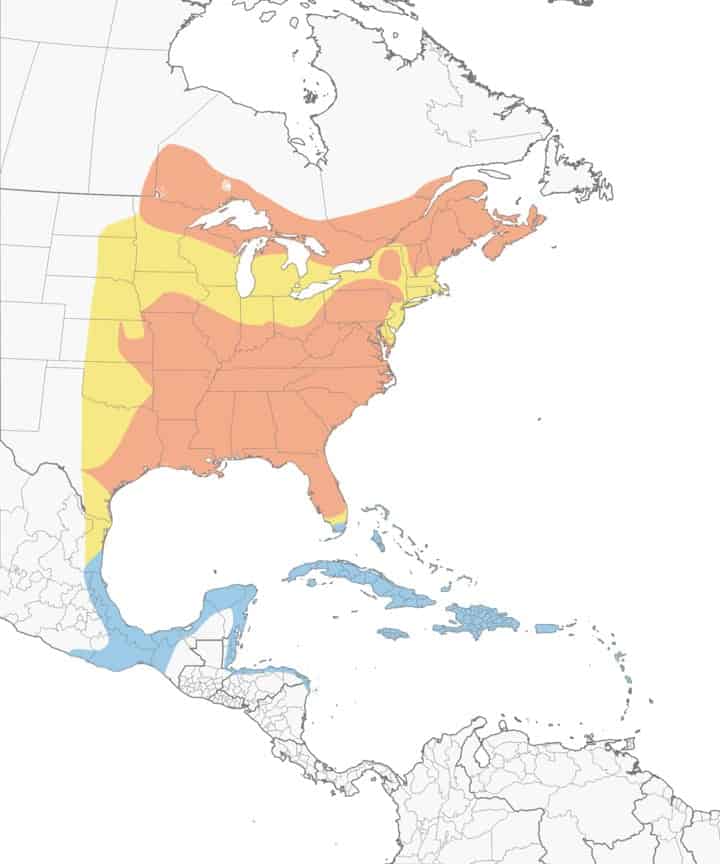
Pinyon Jay
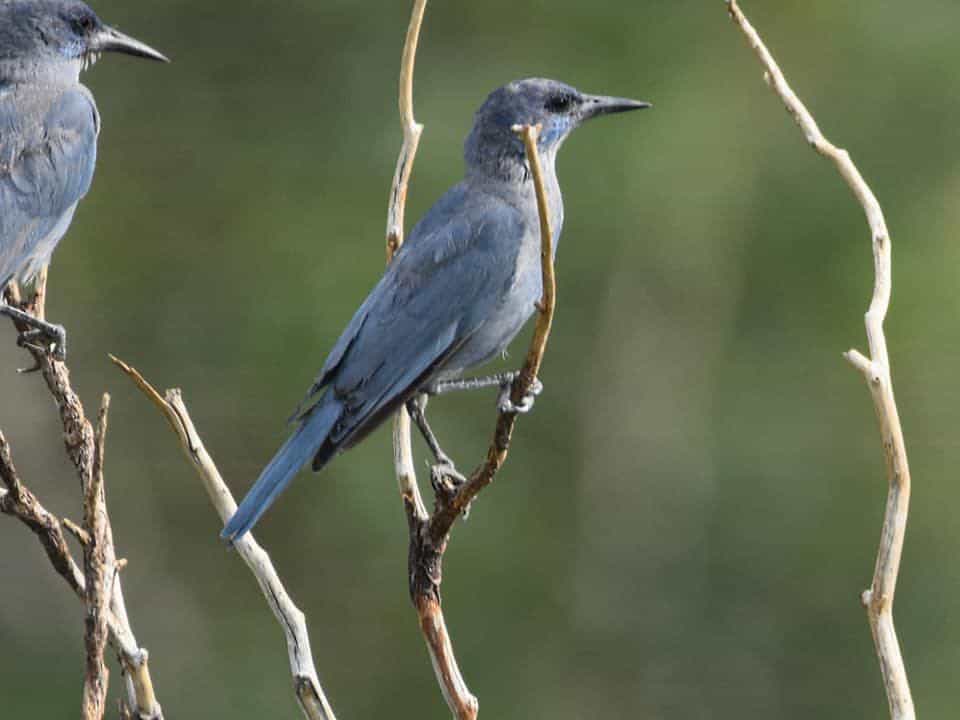
Appearance: 10-11″ long bird, dusty blue body and lighter blue belly and throat, short tail, and no crown. The female looks similar.
Diet: Primarily Pinyon-pine seeds, acorns, fruit, and grains. Also consumes insects, lizards, snakes, nestling birds, and small mammals.
Feeder Food: Whole peanuts, sunflower seeds, suet, cracked corn.
Habitat: Forested areas comprised of Pinyon-juniper, sagebrush, scrub oak, and other pine trees.
Nesting: Large bulky nests of sticks and twigs in the trees about 3-115′ up. 1 brood/season, 2-5 eggs/brood, eggs are 1.3-1.5″ long, pale blue with dark brown specks, incubation last 17 days and young fledge between 21-22 days.
Range Map
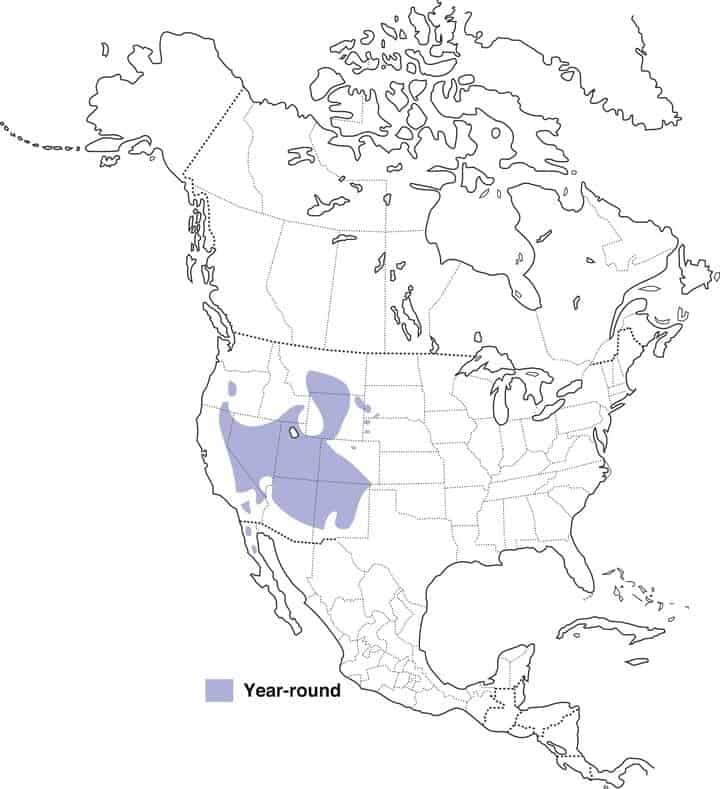
Purple Martin
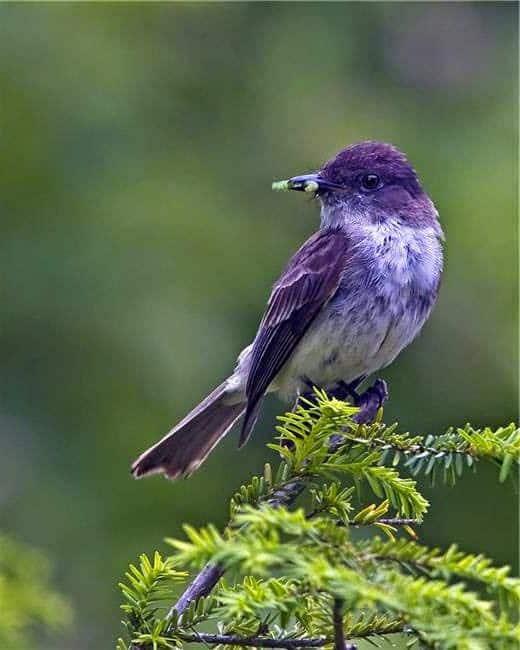
Appearance: The purple martin is a medium bird about 8.5″ long with a blue/purple head, back, and belly with black wings and tail.
Diet: Insects especially dragonflies.
Feeder food: Unlikely to visit a feeder.
Habitat: Usually within 100′ of human dwelling. Purple Martins exist in large colonies.
Nesting: Purple martins are cavity nesters. They primarily use manmade nest boxes which accommodate a colony of birds. They have 1 brood/season, 4-5 white eggs/brood, 15-18 days incubation, and fledge after 26-30 days.
Migration: Purple martins are migrators. They spend the winters in South America and migrate north to breed and raise young.
Breeding range: Pacific northwest coast of Washington, Oregon, and California, parts of Arizona, Utah, and Colorado, the eastern half of the US, and the southern parts of Canada’s Alberta, Manitoba, Saskatchewan, and Ontario.
Winter range: South America
Range Map
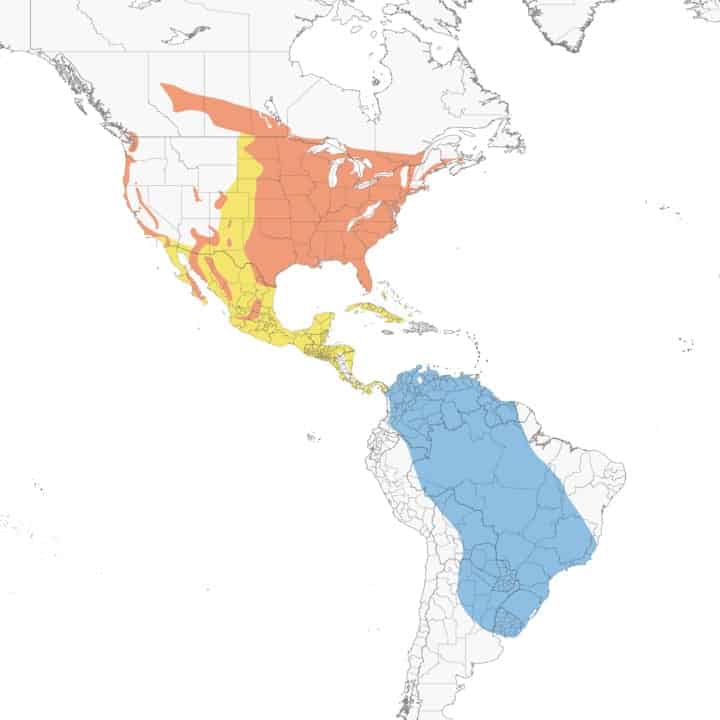
Red-Breasted Nuthatch
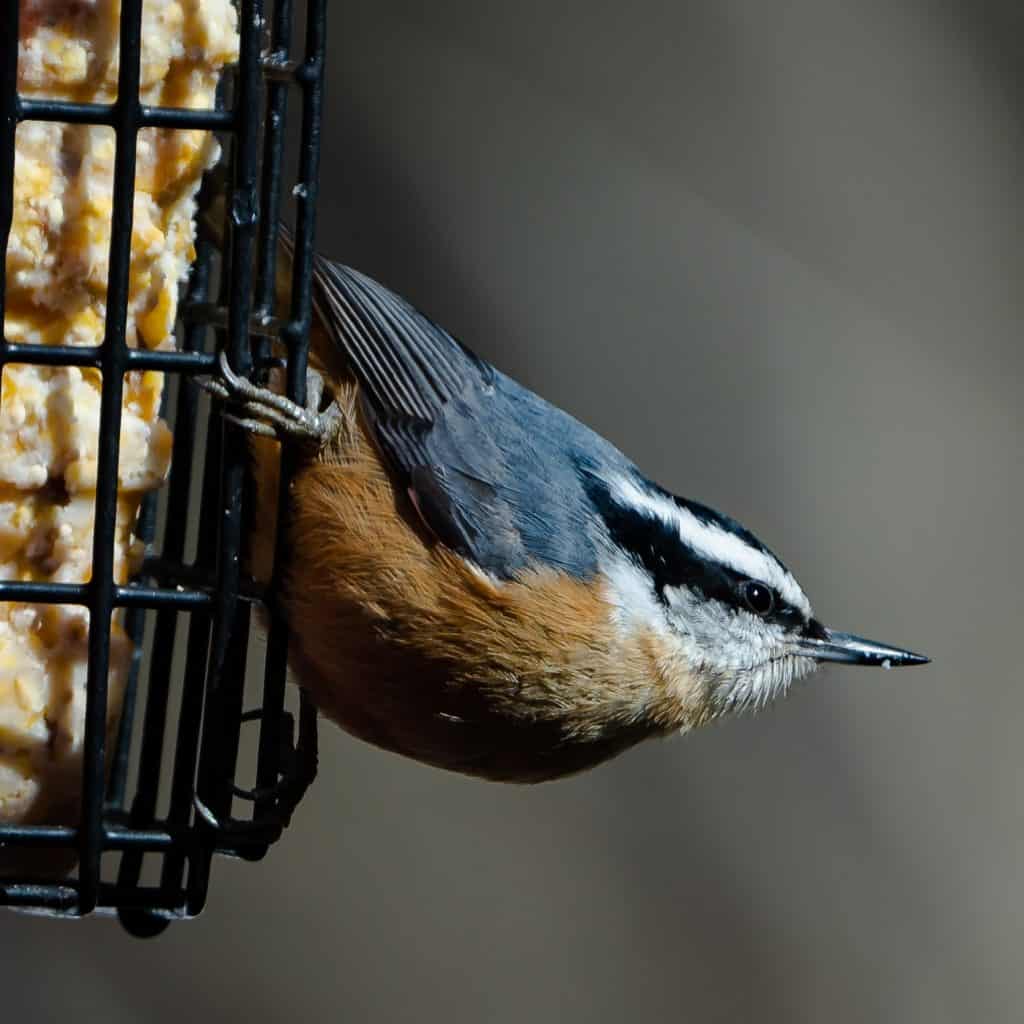
Appearance: The red-breasted nuthatch is a small bird about 4.5″ long, with gray/blue backs, a white head with black stripes running over either eye, orange-cinnamon-colored breast, and a pointy pick-like beak. The females look the same except their underside is a more faded color. Usually spotted climbing upside-down on a deciduous tree foraging for insects beneath the bark.
Diet: Insects, spiders, and other bugs.
Feeder food: Suet, sunflower seeds, shelled peanuts, fruit.
Habitat: Forested areas primarily comprised of coniferous trees (i.e. pines). Woodsy areas of deciduous trees in the east. Southern birds prefer mountainous regions until winter comes in which case they head to lower land.
Nesting: Red-breasted nuthatches are cavity nesters and they prefer to excavate their own holes. They have 1 brood/season, and 6 eggs/brood, eggs are white & speckled with red-brown.
Migration: Red-breasted nuthatches are partial migrators. While many remain in their year-round range, others migrate south for winter.
Year-round range: Southern Alaska, states in the western third of the US, northern Minnesota & Wisconsin, Michigan, Pennsylvania, and New England as well as all Canadian provinces except Nunavut.
Winter range: US states that are not part of the year-round range.
Range Map
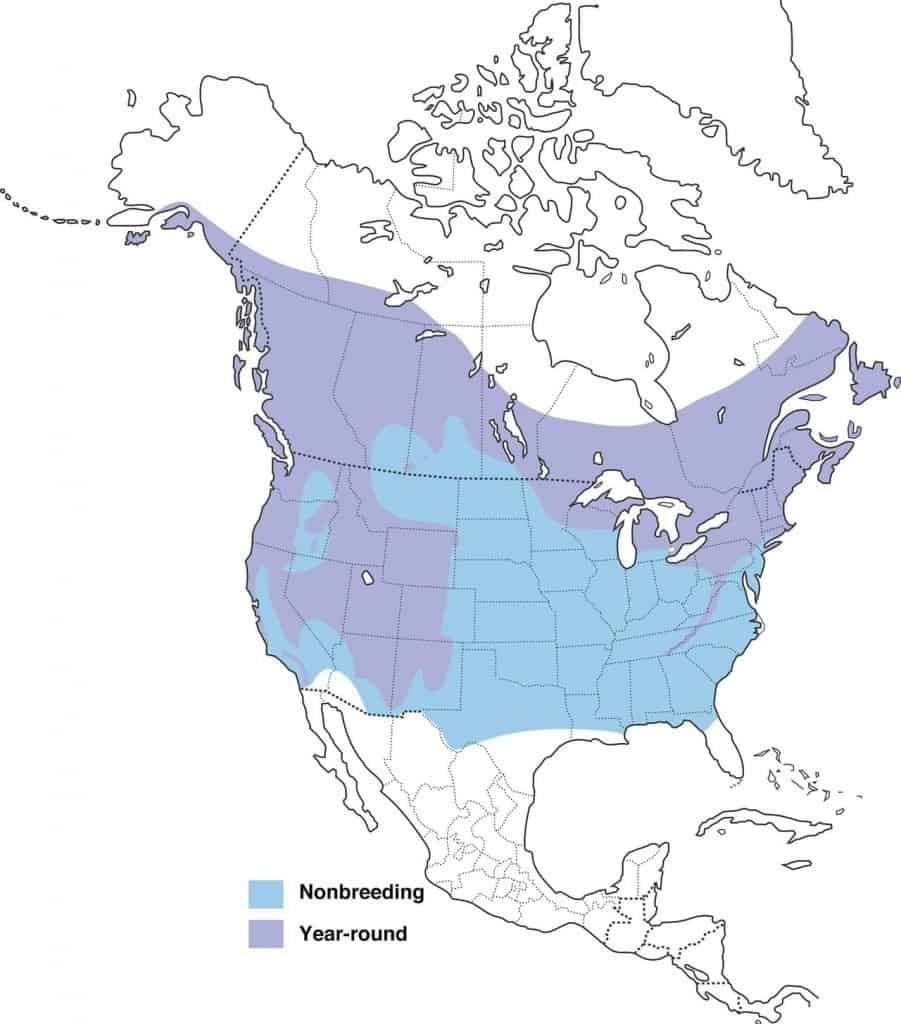
Rock Pigeon
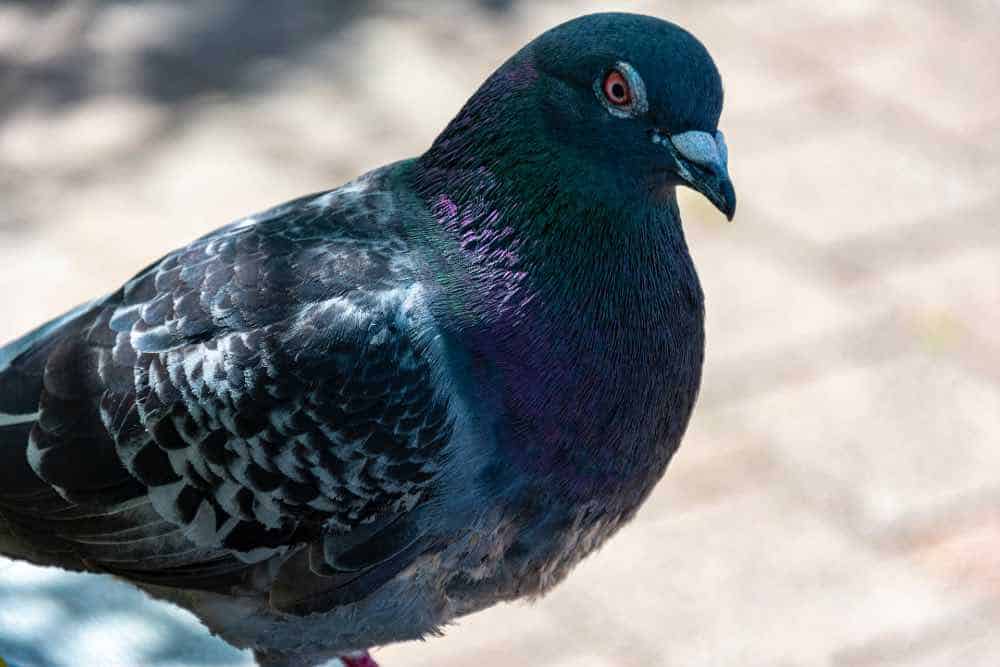
Appearance: Large bird 12-14″ long, chubby with blue/gray wings with black pointy tips, short red legs, black, round wide tail, and iridescent neck.
Diet: Grains, seeds, and fruit. Commonly seen scavenging trash cans for food.
Feeder food: Millet, cracked corn, black-oil sunflower seed, safflower, peanut hearts.
Habitat: Common around cities and towns as well as farmlands
Nesting: Rock pigeons build a large nest of sticks and grass wherever there’s a ledge (e.g. highway overpass, barns, bridges, tall buildings). 1-6 broods/year, 1-3 eggs/brood, eggs are white, incubation about 18 days and the young fledge at about 25-32 days.
Migration: Rock pigeons are not migrators. They remain in their year-round range all seasons of the year.
Year-round range: Every US state, the southernmost edges of Canada, and Mexico.
Range Map
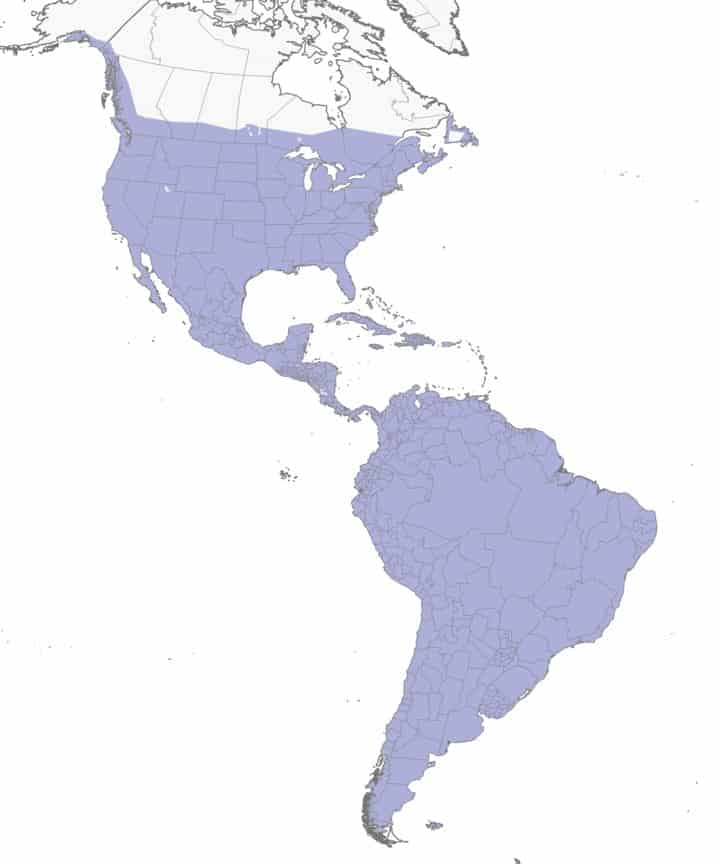
Steller’s Jay
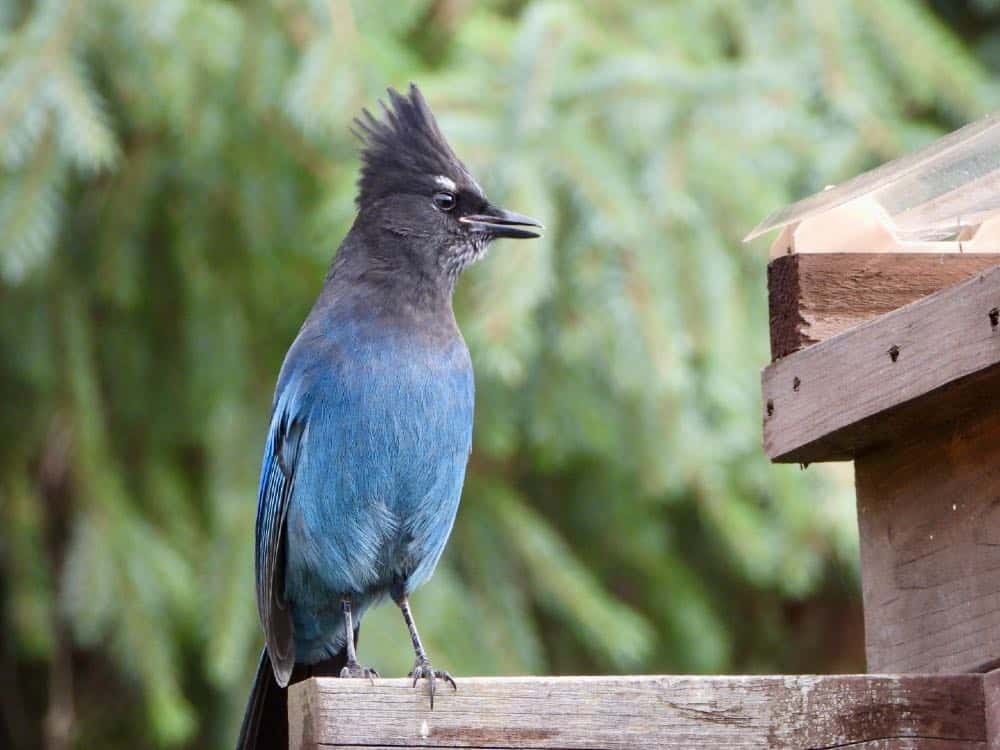
Appearance: Large bird 11.5″ long, dark blue body and crest, black head and crest with spots of blue. Females are similar.
Diet: Nuts, seeds, fruits, insects, other birds’ eggs and nestlings, and small animals.
Feeder Food: Whole peanuts, sunflower seeds, and suet.
Habitat: Typically found in forested areas of mixed tree types – coniferous and deciduous.
Nesting: Large open-cup nest of twigs, bark, and mud located high in a conifer tree. 1 brood/season, 4-5 eggs/brood, eggs are blue/green with dark brown/purple/olive spots, 16-18 days incubation, and the young fledge at about 16-18 days.
Range Map
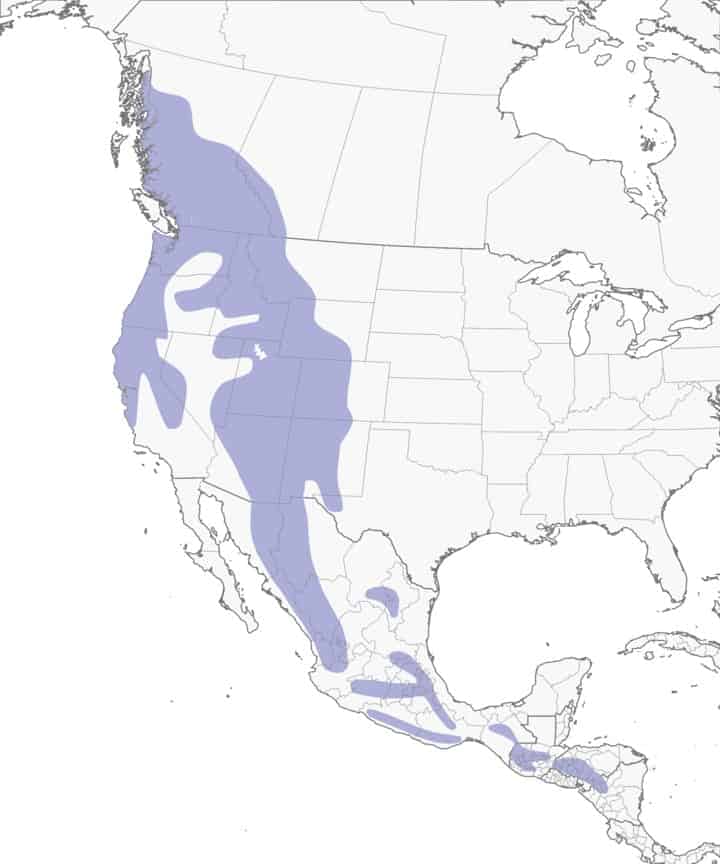
Tree Swallow
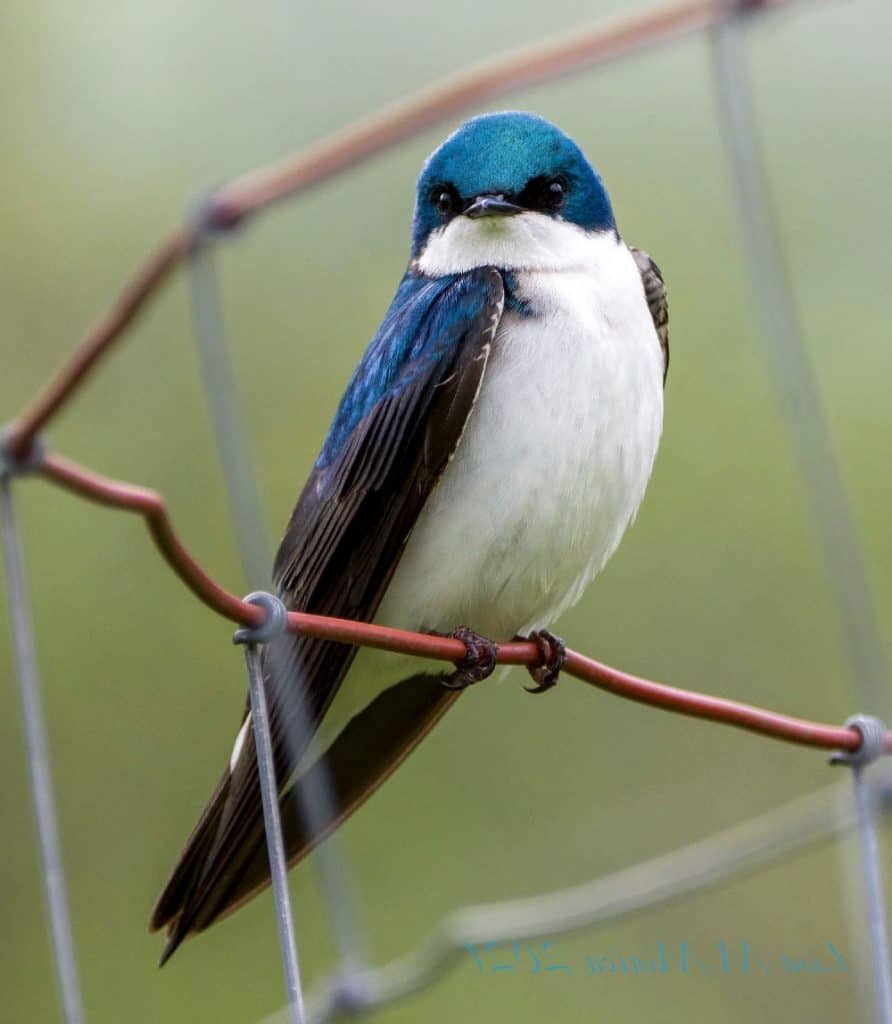
Appearance: 5-6″ long, dark metallic blue to blue/green with a white belly, notched tail, and pointed wing tips. Females have the same coloring but are a bit duller.
Diet: Insects and small fruits.
Feeder Food: Unlikely to visit a feeder.
Habitat: Open areas such as fields, large lawns, and marshes.
Nesting: Tree swallows are cavity nesters. They often take up residence in an old dead tree or existing hole left behind by other cavity nesters. They have 2-8 eggs, eggs are light pink then slowly fade to white. Incubation is 14-15 days and young fledge at about 18-22 days.
Range Map
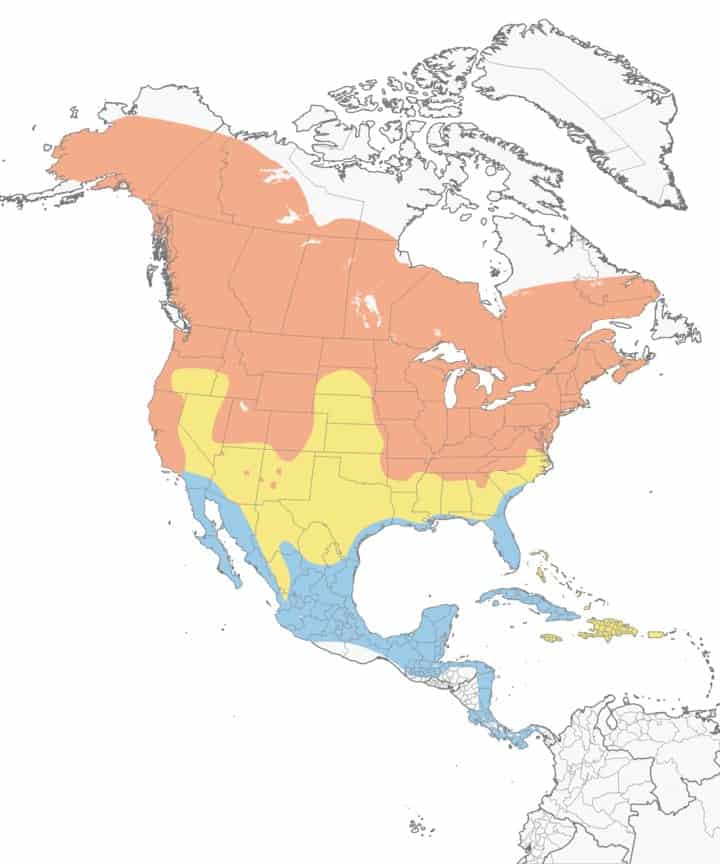
Western Bluebird
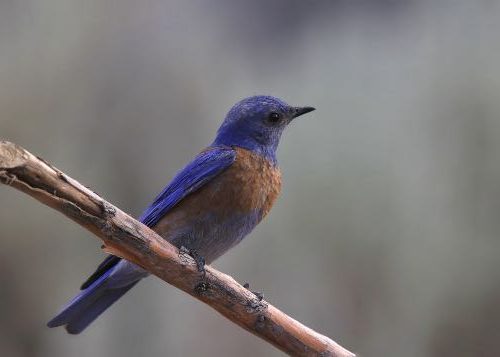
Appearance: Small bird 7″ long, deep blue underparts, orange-chestnut back and breast. Female gray/blue, light blue wings and tail, and pale chestnut breast.
Diet: Insects, fruits & berries.
Feeder Food: Mealworms
Habitat: Open woodlands especially those with pines and oaks, orchards, and farmland with some trees.
Nesting:
Nest: Cavity nesters – old woodpecker hold or manmade nesting box.
Brood: 2 broods/season
Clutch: 4-5 eggs/brood
Egg color: Pale blue without blemishes, although sometimes are white
Egg size: Length: 0.8-2.4″ x Width: .8″
Incubation: 12-18 days and young fledge at about 20 days.
Range Map

White-Breasted Nuthatch
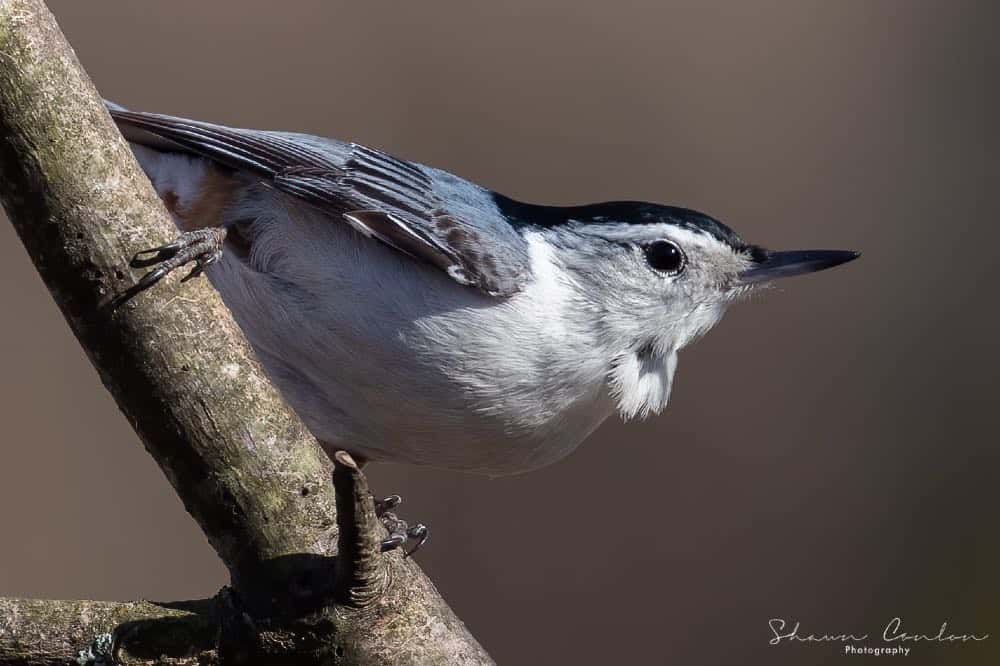
Appearance: 5-6″ long, gray/blue back, white head with a black cap, chestnut under the tail, and a long thin pick-like beak. Females look similar except their cap and neck are gray. Usually spotted climbing upside-down on a deciduous tree foraging for insects beneath the bark.
Diet: Insects & seeds.
Feeder food: Suet, sunflower seed, shelled peanuts.
Habitat: Near mature deciduous and mixed forests; wooded suburban areas such as orchards, parks, and backyards.
Nesting: White-breasted nuthatches are cavity nesters. They have 1 brood/season, 5-9 eggs/brood, eggs are white with brown markings, incubation is 11-12 days and young fledge at about 13-14 days.
Migration: White-breasted nuthatches are not migrators. They remain in their year-round range all seasons of the year. That said, a small part of the population may migrate to a strip in the southcentral US for the winter.
Year-round range: Every US state, Canada’s southern provinces, and Mexico.
Range Map
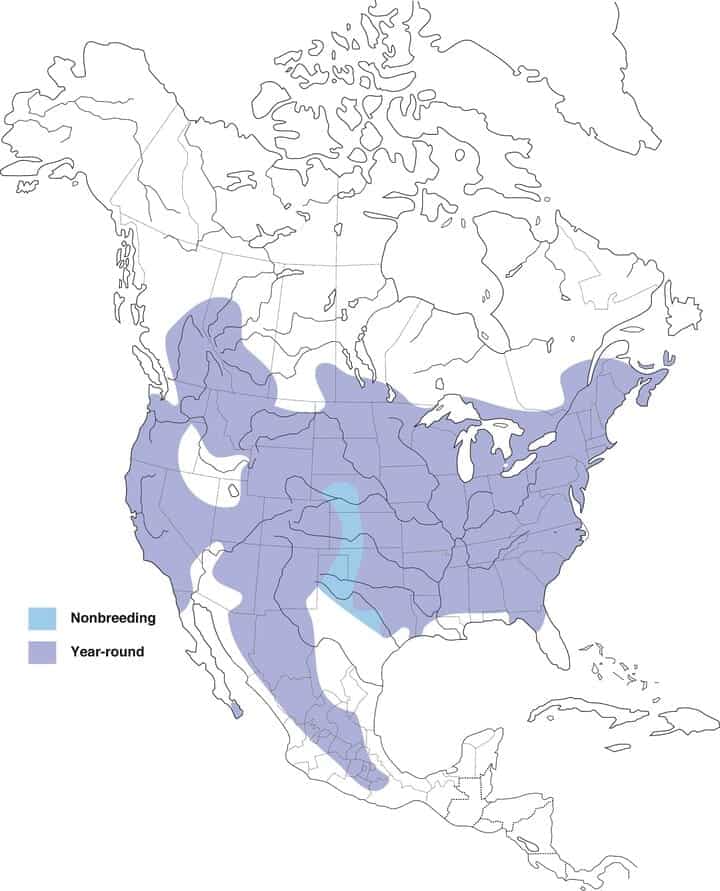
Woodhouse’s Scrub-Jay
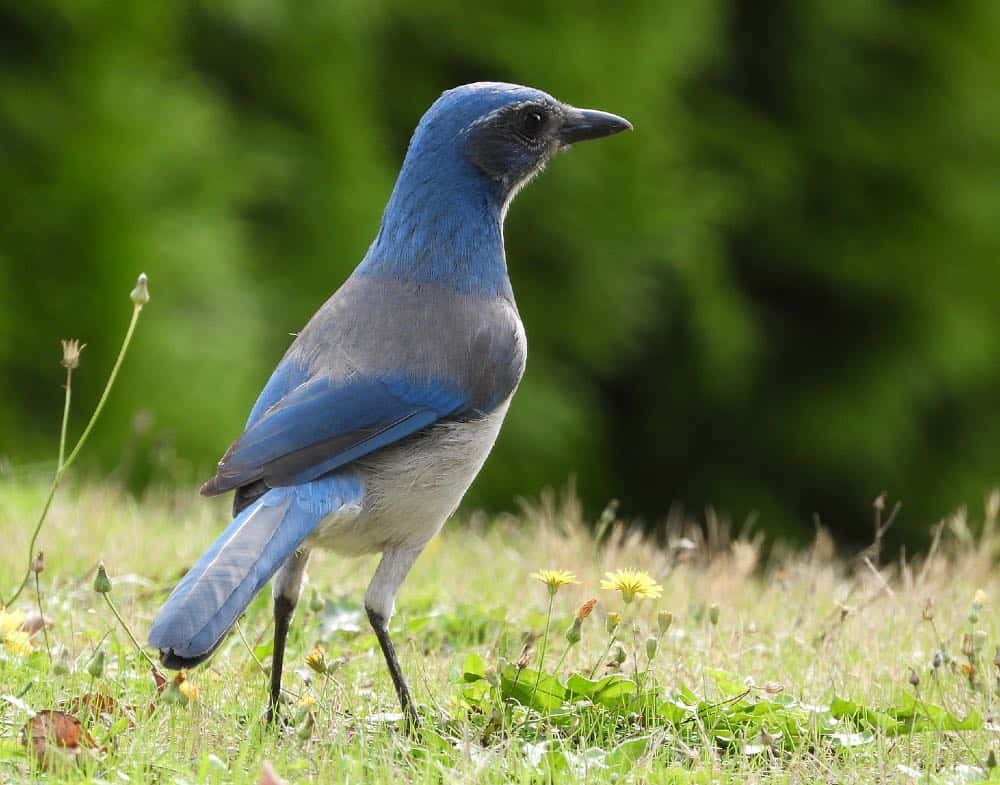
| Appearance | 11-12″ large bird, light blue and gray, white throat, gray belly separated by an indistinct, angled stripe of bright blue on chest, and long wide tail. Female are similar. |
| Diet | Insects, fruit, nuts, seeds, lizards and nestling birds, sometimes finding nests. |
| Feeder Food | Whole peanuts, sunflower seeds. |
| Habitat | Pinyon pine habitats, dry shrublands of Nevada on south, suburbs and parks. |
| Nesting | Basket shaped nest of twigs and plant in pinyon pine or shrub between 6-14′ up. 1-5 eggs, eggs .9-1.3″ long, pale green blotched with olive, or pale gray spotted with brown. Incubation 17-19 days and long fledge 17-19 days. |
Range Map
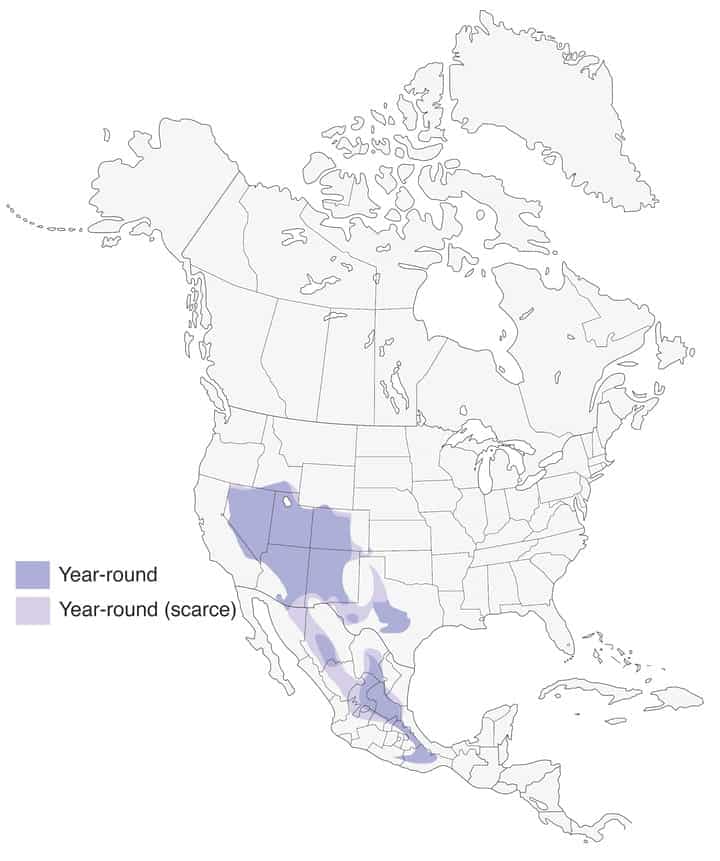
Keep this article handy because I guarantee when you see an amazing blue bird you WILL want to know the species and details about it. Trust me!
Happy Birding!
Sources
All About Birds. The Cornell Lab of Ornithology. 2021
eBird. The Cornell Lab of Ornithology. 2021
Tekiela, Stan. Birds of Wisconsin Field Guide. 1999
Noah, Strycker, and Alderfer Jonathan. National Geographic Backyard Guide to the Birds of North America. 2nd ed., National Geographic, 2019.

